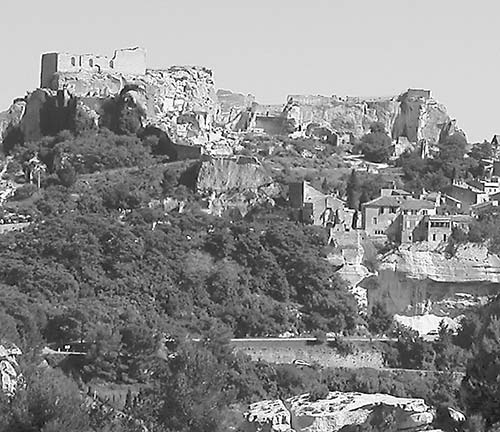
Les Baux is actually two visits in one: castle ruins perched on an almost lunar landscape, and a medieval town below. Savor the castle, then tour—or blitz—the lower town’s polished-stone gauntlet of boutiques. While the town, which lives entirely off tourism, is packed with shops, cafés, and tourist knickknacks, the castle above stays manageable because crowds are dispersed over a big area. The town’s main drag leads directly to the castle—just keep going uphill (a 10-minute walk).
Tourist Information: The TI is immediately on the left as you enter the village (daily 9:00-18:00, shorter hours and closed Sun in off-season). The TI can call a cab for you if you need one.
The sun-bleached ruins of the stone fortress of Les Baux are carved into, out of, and on top of a rock 650 feet above the valley floor. Many of the ancient walls of this striking castle still stand as a testament to the proud past of this once-feisty village.
Cost: €9, €11 if there’s “entertainment” (described below), €16 Pass Provence combo-ticket with Carrières de Lumières and Yves Brayer Museum (€18 if there is entertainment at Les Baux), entry fees include excellent audioguide.

Hours: Daily 9:00-19:00 (July-Aug until 20:00), March and Oct 9:30-18:30, Nov-Feb 10:00-17:00, www.chateau-baux-provence.com. If you’re inside the castle when the entry closes, you can stay as long as you like.
Entertainment: Every weekend from April through early September and daily in summer, the castle presents medieval pageantry, tournaments, demonstrations of catapults and crossbows, and jousting matches. Pick up a schedule as you enter (or check online).
Picnicking: While no food or drink is sold inside the castle grounds, you’re welcome to bring your own and use one of several picnic tables (the best view table is at the edge near the siege weaponry). Sunset dinner picnics are memorable.
Background: Imagine the importance of this citadel in the Middle Ages, when the Lords of Baux were notorious warriors (who could trace their lineage back to one of the “three kings” of Christmas-carol fame, Balthazar). In the 11th century, Les Baux was a powerhouse in southern France, controlling about 80 towns. The Lords of Baux fought the counts of Barcelona for control of Provence...and eventually lost. But while in power, these guys were mean. One ruler enjoyed forcing unransomed prisoners to jump off his castle walls.
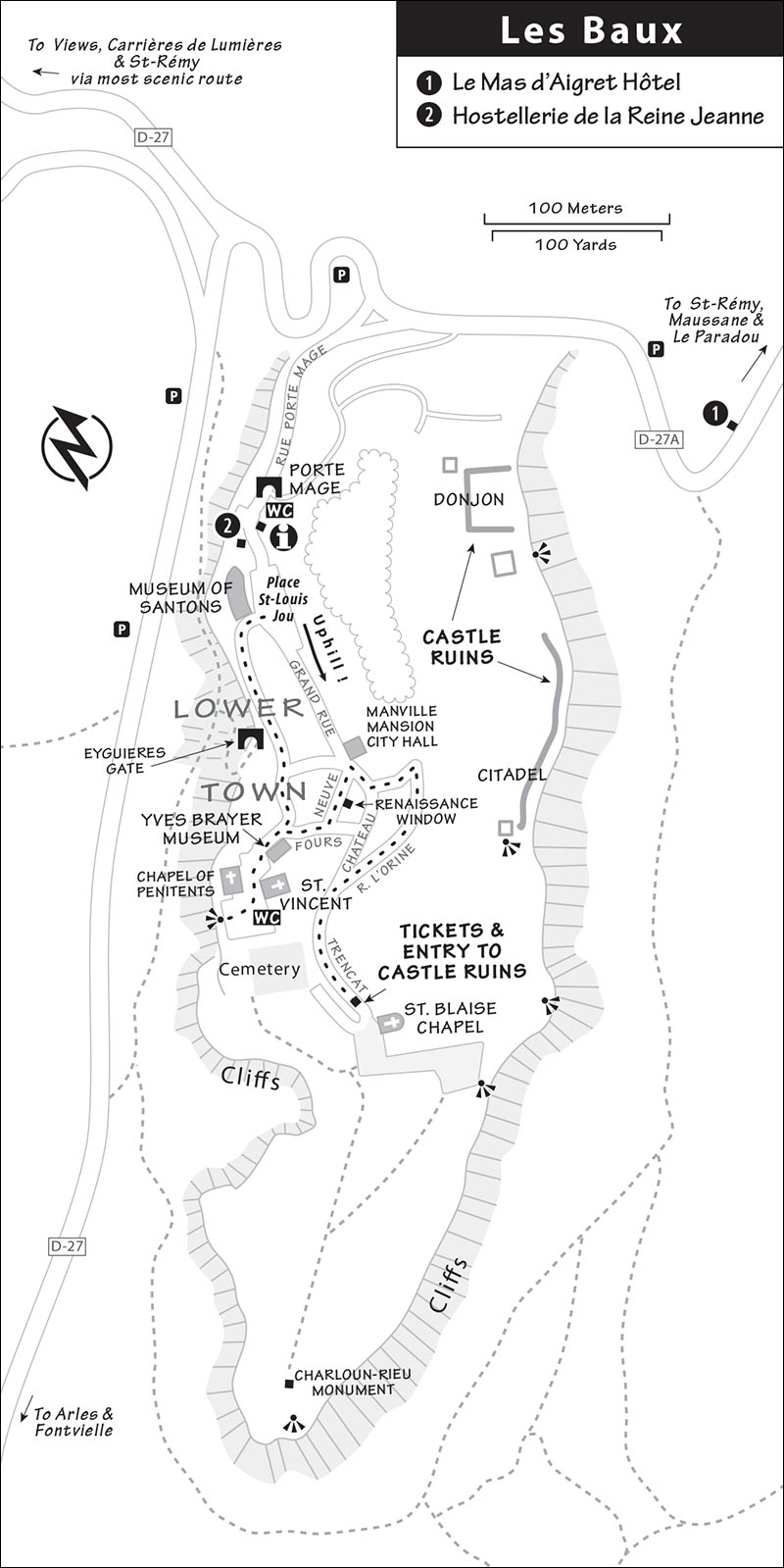
In 1426, Les Baux was incorporated into Provence and France. Not accustomed to playing second fiddle, Les Baux struggled with the French king, who responded by destroying the fortress in 1483. Later, Les Baux regained some importance and emerged as a center of Protestantism. Arguing with Rome was a high-stakes game in the 17th century, and Les Baux’s association with the Huguenots brought destruction again in 1632 when Cardinal Richelieu (under King Louis XIII) demolished the castle. Louis rubbed salt in the wound by billing Les Baux’s residents for his demolition expenses. The once-powerful town of 4,000 was forever crushed.
Visiting the Castle: Buy your ticket and inspect the models of Les Baux before its 17th-century destruction. Pick up your included audioguide when you enter. As you wander, key in the number for any of the 30 narrated stops that interest you.

The sight is exceptionally well presented. As you walk on the windblown spur (baux in French), you’ll pass kid-thrilling medieval siege weaponry (go ahead, try the battering ram). Good displays in English and big paintings in key locations help reconstruct the place. Imagine 4,000 people living up here. Notice the water-catchment system (a slanted field that caught rainwater and drained it into cisterns—necessary during a siege) and find the reservoir cut into the rock below the castle’s highest point. Look for post holes throughout the stone walls that reveal where beams once supported floors.
For the most sensational views, climb to the blustery top of the citadel—hold tight if the mistral wind is blowing.
After your castle visit, you can shop and eat your way back through the lower town. Or, escape some of the crowds by visiting these minor but worthwhile sights as you descend. I’ve linked the sights with walking directions.
• Follow the main drag about 100 yards through the town and look for the flags marking...
The 15th-century City Hall offers art exhibits under its cool vaults. It often flies the red-and-white flag of Monaco amid several others, a reminder that the Grimaldi family (longtime rulers of the tiny principality of Monaco) owned Les Baux until the French Revolution (1789). In fact, in 1982, Princess Grace Kelly and her royal husband, Prince Rainier Grimaldi, came to Les Baux to receive the key to the city.
Exit left and walk uphill 20 steps to the empty 1571 Renaissance window frame. This beautiful stone frame stands as a reminder of this town’s Protestant history. This was probably a place of Huguenot worship—the words carved into the lintel, Post tenebras lux, were a popular Calvinist slogan: “After the shadow comes the light.”
• Continue walking uphill, and turn right on the first street to find the...
This enjoyable museum lets you peruse three small floors of luminous paintings (Van Gogh-like Expressionism) by Yves Brayer (1907-1990), who spent his final years here in Les Baux. Like Van Gogh, Brayer was inspired by all that surrounded him, and by his travels through Morocco, Spain, and the rest of the Mediterranean world. Ask about the English information sheet at the entry.
Cost and Hours: €8, covered by Pass Provence combo-ticket, daily 10:00-12:30 & 14:00-18:30, shorter hours and closed Tue and all of Jan-Feb in off-season, tel. 04 90 54 36 99, www.yvesbrayer.com.
• Next door is...
This 12th-century Romanesque church was built short and wide to fit the terrain. The center chapel on the right (partially carved out of the rock) houses the town’s traditional Provençal processional chariot. Each Christmas Eve, a ram pulls this cart—holding a lamb, symbolizing Jesus, and surrounded by candles—through town to the church.
• As you leave the church, WCs are to the left (dug into the stone wall) and up the stairs. Directly in front of the church is a vast view, making clear the strategic value of this rocky bluff’s natural fortifications. A few steps away is the...
The elaborate Nativity scene painted by Yves Brayer covers the entire interior and illustrates the local legend that says Jesus was born in Les Baux.
• As you leave the church, turn left and find the old town “laundry”—with a pig-snout faucet and 14th-century stone washing surface designed for short women.
Continue past the Yves Brayer Museum again, keep left, and curve down Rue de la Calade, passing a view café, the town’s fortified wall, and one of its two gates. At the end you’ll run into the...
This free and fun “museum” displays a collection of santons (“little saints”), popular folk figurines that decorate local Christmas mangers. Notice how the Nativity scene “proves” once again that Jesus was born in Les Baux. These painted clay dolls show off local dress and traditions (with good English descriptions).
A 15-minute walk from Les Baux, this colossal quarry-cave with immense vertical walls offers a mesmerizing sound-and-slide experience. Enter a darkened world filled with floor-to-ceiling images and booming music. Wander through a complex of cathedral-like aisles, transepts, and choirs (no seating provided) as you experience the spectacle. There’s no storyline to follow, but information panels by the café give some background. The show lasts 40 minutes and runs continuously. If you’d like an intermission, you can exit the “show” into a part of the quarry that opens to the sky and take a break at the café before re-entering. Dress warmly, as the cave is cool.
Cost and Hours: €12.50, covered by Pass Provence combo-ticket; daily 9:30-19:30, Nov-March 10:00-18:00; tel. 04 90 54 47 37, www.carrieres-lumieres.com.
Sleeping: Take your pick of a small inn just outside Les Baux or another one within the lower town.
$$ Le Mas d’Aigret*** is a 10-minute walk east of Les Baux on the road to St-Rémy (D-27). From this comfy refuge, you can gaze up at the castle walls rising beyond the heated swimming pool, or enjoy valley views from the groomed terraces. The rooms are tastefully appointed—10 have great views and decks or terraces (convenient half-pension dinner and breakfast option, air-con, pétanque courts, tel. 04 90 54 20 00, www.masdaigret.com, contact@masdaigret.com).
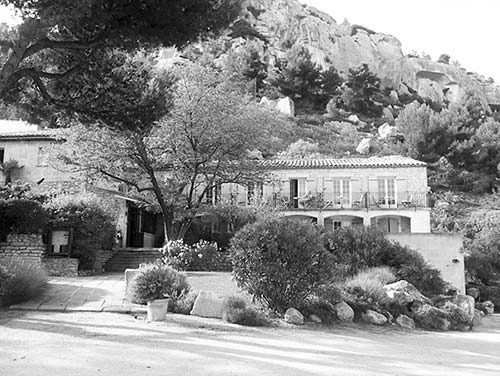
$ Hostellerie de la Reine Jeanne** is just inside the gate to Les Baux, across from the TI. The easygoing owners rent four good-value rooms above their popular restaurant (family rooms, air-con, for view deck ask for chambre avec terrasse, tel. 04 90 54 32 06, www.la-reinejeanne.com, marc.braglia@wanadoo.fr).
Eating: You’ll find quiet cafés with views as you follow my walking directions through Les Baux’s lower town. The recommended $ Hostellerie de la Reine Jeanne offers friendly service and good-value meals indoors or out (open daily).
There are also a few worthwhile places in the untouristed village of Maussane, a few minutes’ drive south of Les Baux (and 15 minutes from Arles). Place de la Fontaine, the town’s central square, makes a good stop for café fare. $ Pizza Brun has tasty wood-fired pizza to take out or eat in with fun seating indoors and out (closed Mon, 1 Rue Edouard Foscalina; with your back to Place de la Fontaine, walk to the right for about 10 minutes and look for colored tables in an alleyway; tel. 04 90 54 40 73).
Sophisticated and sassy, St-Rémy (sahn ray-mee) gave birth to Nostradamus and cared for a distraught artist. Today, it caters to shoppers and Van Gogh fans. A few minutes from the town center, you can visit the once-thriving Roman city called Glanum and the psychiatric ward where Vincent van Gogh was sent after lopping off his earlobe. Best of all is the chance to elbow your way through St-Rémy’s raucous Wednesday market. A ring road hems in a fun-filled pedestrian-friendly center that’s fully loaded with fine foods, beauticians, art galleries, and the latest Provençal fashions.
By Car: From Les Baux, St-Rémy is a spectacular 15-minute drive over the hills and through the woods. Roads D-5 and D-27 each provide scenic routes between these towns, making a loop drive between them worthwhile (the most scenic approach is on D-27).
Parking in St-Rémy is tricky; it’s easiest at the pay lot by the TI. You can park for free but less centrally by the cemetery (see the “St-Rémy Area” map).
By Bus: It’s one hour from Arles via bus #54 (5/day Mon-Fri, 3/day Sat, none on Sun) or bus #57 (6/day, daily July-Aug, Sat-Sun only in early May-June and Sept, none in off-season) and 45 minutes from Avignon via bus #57 (12/day Mon-Fri, 6/day Sat-Sun). If arriving in St-Rémy by bus, get off on the ring road at the République stop and continue uphill. The TI is a block up Avenue Durand Maillane (to the right).
By Taxi: From Les Baux, allow €20 one-way; from Avignon, count on €40 (mobile 06 14 81 34 85 or 06 25 17 00 73).
By Bike: Rent all sorts of bikes (including electric bikes) at Sun-e-Bike (2 Rue Camille Pelletan, tel. 04 32 62 08 39, www.location-velo-provence.com).
From St-Rémy’s circular center, it’s a 20-minute walk along a busy road with no sidewalk to Glanum and the St. Paul Monastery (Van Gogh’s psychiatric hospital).
Tourist Information: The TI is two blocks toward Les Baux from the ring road (Mon-Sat 9:00-12:30 & 14:00-18:30, Sun 10:00-12:30, tel. 04 90 92 05 22, www.saintremy-de-provence.com). Pick up bus schedules, hiking maps, and a town map that includes Van Gogh’s favorite painting locations. The TI can also call a cab for you.
Helpful Hints: St-Rémy’s Wednesday market swallows Place de République with clothing, fabric, and bric-a-brac, and spreads along the town’s traffic-free lanes selling anything Provençal. You’ll find produce on picturesque Place Pelisser (by City Hall). The market wraps up by about 12:30.
St-Rémy’s key sights—the ruins at Glanum and the hospital where Vincent van Gogh was treated—are an unappealing 20-minute walk south of the TI. If you’re driving, you can park for free at the St. Paul Monastery (coming from Les Baux, it’s the first right after passing Glanum) and walk a few minutes on a footpath to Glanum from there (or pay to park at the Glanum site; leave nothing of value in your car).
The still-functioning psychiatric hospital (Clinique St. Paul) that treated Vincent van Gogh from 1889 to 1890 is a popular pilgrimage for Van Gogh fans. Here you’ll enter Van Gogh’s temporarily peaceful world: a small chapel, intimate cloisters, a re-creation of his room, and a small lavender field with several large displays featuring copies of his paintings. There’s also a display about sculptor Camille Claudel, who also sought solace in St-Rémy following a tumultuous affair with Auguste Rodin.
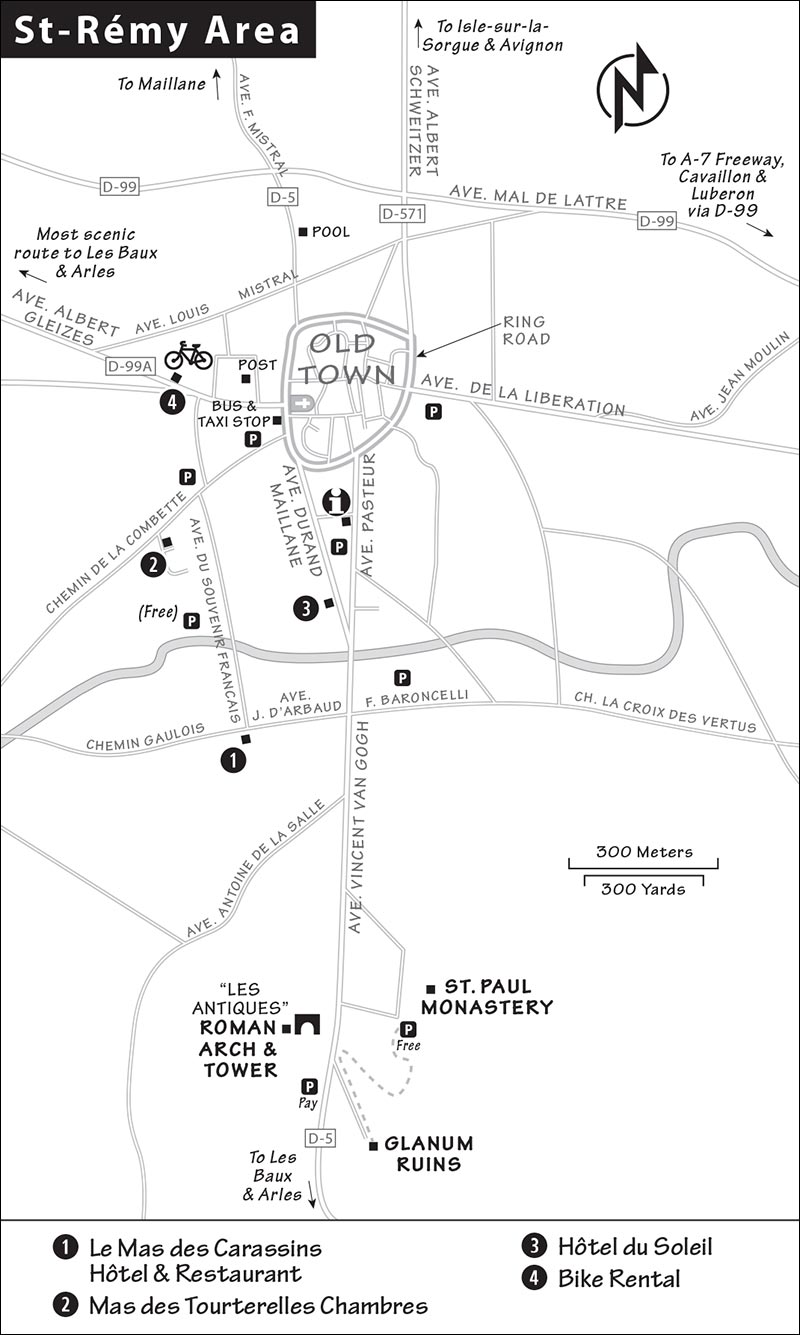
Cost and Hours: €5; daily 9:30-18:30, Oct-March 10:15-16:30, closed Jan-mid-Feb; tel. 04 90 92 77 00, www.saintpauldemausole.fr.
Visiting the Hospital: Inside, read the thoughtful English explanations about Van Gogh’s tortured life. Amazingly, in his 53 weeks here, the artist completed 143 paintings and more than 100 drawings. In and around the complex, you’ll see copies of his works—some positioned right where he painted them. Several are located through the gift shop in a lavender garden. Stand among flame-like cypress trees, gazing over the Alpilles mountains, and realize you’re in the midst of some of Van Gogh’s most famous creations.
You’ll also find memories here of another troubled artist, Camille Claudel (1864-1943), whose parents had her committed to a nearby mental ward after her anguished affair with sculptor Auguste Rodin. Watch for a re-creation of her kitchen and see a short video about her life.
These crumbling stones are the foundations of a Roman market town, located at the crossroads of two ancient trade routes between Italy and Spain. While the ruins are, well...ruined, their setting at the base of the rocky Alpilles is splendid. It’s also unshaded and can be very hot (making it easier to enjoy early or late).
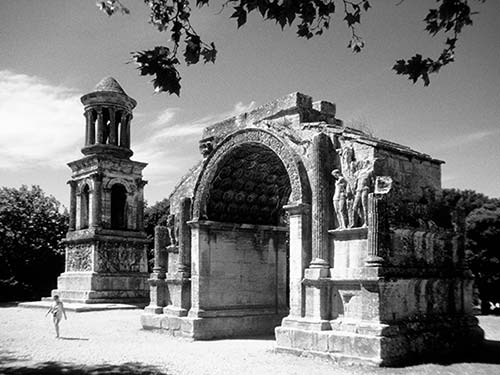
A stubby Roman arch and tall tower stand across the road from the site as proud reminders of the town’s glory days. These lonely monuments marked the entry to Glanum 2,000 years ago. The plump triumphal arch was designed to impress visitors with scenes of Rome’s power, and the tower was built as a mausoleum by one of Glanum’s most distinguished families.
Cost and Hours: €8; daily 9:30-18:30; Oct-March Tue-Sun 10:00-17:00, closed Mon; parking-€3/day, tel. 04 90 92 23 79.
Visiting the Ruins: Start at the helpful little museum at the entrance, with good English explanations of key buildings and the excavation process, as well as a model of Glanum in its prime. The free English handout and information panels scattered about the site provide more context to the ruins you’ll see. Serious students of ancient Rome will want to spring for the well-done Itineraries book (€7).
The Roman site was founded in 27 BC and occupied for about 30 years. About 2,500 people lived in Glanum at its zenith (the Roman city was about seven times bigger than the ruins you see today). And though this was an important town, with grand villas, temples, a basilica, a forum, a wooden dam, and aqueducts, it was not important enough to justify an arena or a theater (such as those in Arles, Nîmes, and Orange). Stroll up Glanum’s main street and see remains of a market hall, a forum, thermal baths, reservoirs, and more. The view from the belvedere justifies the uphill effort. These ruins highlight the range and prosperity of the Roman Empire.
Unless otherwise noted, the following hotels have easy parking and air-conditioning.
$$ Le Mas des Carassins,*** a 15-minute walk from the center, is well-run by Michel and Pierre. Luxury is affordable here, with two generously sized pools, ample outdoor lounging spaces, big gardens, and everything just so. The 22 rooms are split between the more traditional main building (which I prefer) and the newer annex, which comes with larger rooms and more modern decor (American-style breakfast, table tennis, great dinner option—see below, 1 Chemin Gaulois, tel. 04 90 92 15 48, www.masdescarassins.com, info@masdescarassins.com).
$$ Mas des Tourterelles Chambres, a Provençal farmhouse in a pleasant neighborhood, is a 10-minute walk from the town center. It has six sharp rooms and an apartment, pool, and small garden with outdoor picnic facilities including a fridge (2-night minimum, air-con in top-floor rooms—others don’t need it, 21 Chemin de la Combette, tel. 09 54 64 83 30 or mobile 06 15 87 24 55, www.masdestourterelles.com, contact@masdestourterelles.com). Turn right at the top of Place de la République onto Chemin de la Combette; after 400 yards look for the brown sign down a lane on the left (just after the second speed bump).
$$ Hôtel du Soleil,** a 10-minute walk from St-Rémy’s center, is a sharp hotel, with fresh white stone and beige decor throughout. Its spotless rooms cluster around a courtyard/parking area and pool (five rooms have small terraces, a block above the TI at 35 Avenue Pasteur, tel. 04 90 92 00 63, www.hotelsoleil.com, info@hotelsoleil.com).
$ Sommeil des Fées Chambres rents five simple, clean, and comfortable rooms in the center of St-Rémy. They also run a good restaurant, La Cuisine des Anges, described later (4 Rue du 8 Mai 1945, tel. 04 90 92 17 66, www.angesetfees-stremy.com).
The town is packed with restaurants, each trying to outdo the other. Join the evening strollers and compare.
$$$ Le Mas des Carassins offers a four-course food experience worth booking ahead. One menu is prepared each night and served in a country-classy setting inside or out. Service is friendly, kids are welcome, and the cuisine is utterly delicious. Review their website to see what’s cooking before booking a table (see listing under “Sleeping in St-Rémy,” earlier).
$ Crêperie Lou Planet, on pleasant Place Favier, is cheap and peaceful, with outdoor seating in summer, tasty crêpes, good salads, and inexpensive, good house wine. (daily April-Sept 12:00-22:00, behind Hôtel de Ville at Place Favier, next to Musée des Alpilles).
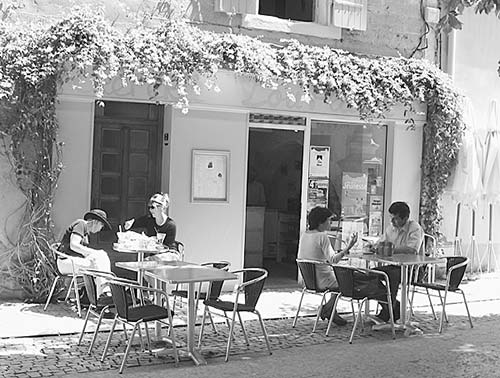
$$ Bar-Tabac des Alpilles, popular with locals, has an old-school-meets-new-world feel, with wine barrels, wood tables, and modern art. The menu offers just enough choice, including salads, plats, and a fairly priced menu. Dinner is served inside or out in two seatings, at 19:15 and 20:45; best to book ahead (daily, 21 Boulevard Victor Hugo, tel. 04 90 92 02 17).
$$ Café de la Place, on Place de la République behind the parking lot, is a hit with St-Rémy’s young people (as well as aging travel writers). Come for a coffee, a drink, or a good meal of basic café fare (big terrasse, open daily, tel. 04 90 92 02 13).
$$ La Cuisine des Anges is a welcoming place serving tasty cuisine with a Mediterranean accent in a pleasant courtyard or dining room (closed Thu, 4 Rue du 8 Mai 1945, tel. 04 90 92 17 66).
$$$ L’Aile ou la Cuisse is St-Rémy’s vintage bistro, with a warm, classy interior and traditional cuisine (daily, 5 Rue de la Commune, tel. 04 32 62 00 25).
Orange is notable for its grand Roman arch and exceptional Roman Theater. Called “Arausio” in Roman times, Orange was a thriving city in those days—strategically situated on the Via Agrippa, connecting the important Roman cities of Lyon and Arles. It was founded as a comfortable place for Roman army officers to enjoy their retirement. Did the emperor want thousands of well-trained, relatively young guys hanging around Rome? No way. What to do? “How about a nice place in the south of France...?”
Today’s Orange (oh-rahnzh) is a busy, workaday city with a gritty charm that reminds me of Arles. Leafy café-lined squares, a handful of traffic-free streets, a fine Hôtel de Ville (City Hall), and that theater all give the town some serious street appeal. For some, Orange works well as a base, with its quick access to the Côtes du Rhône wine villages by car (slower but OK by bus) and quick rail access to Avignon (which even drivers should consider).
The unnecessary TI is located next to the fountain and parking area at 5 Cours Aristide Briand (Mon-Sat 9:00-12:30 & 14:00-18:00—no lunch break July-Aug, Sun 9:00-12:30; shorter hours and closed Sun Oct-March; tel. 04 90 34 70 88, www.orange-tourisme.fr).
Market Day: Thursday is market day, and it’s a big deal here, with all the town’s streets and squares crammed with produce and local goods for sale until 12:30. I like this market because it focuses on locals’ needs and not touristy kitsch.
By Train: Orange’s train station is a level 15-minute walk from the Roman Theater (or an €8 taxi ride, mobile 06 66 71 58 02). Sadly, there’s no bag storage in Orange. To walk into town from the station, head straight out of the station (down Avenue Frédéric Mistral), merge left onto Orange’s main shopping street (Rue de la République), then turn left on Rue Caristie; you’ll run into the Roman Theater’s massive stage wall.
By Bus: All buses stop at Cours Pourtoules, two blocks from the Roman Theater; the bus to Vaison-la-Romaine also stops at the train station.
By Car: Follow Centre-Ville signs, then Office du Tourisme or Théâtre Antique signs; park as close to the Roman Theater’s huge wall as you can. If coming from Avignon on D-907, park where you see Parking Théâtre signs; if coming from the autoroute, park near the TI on Cours Aristide Briand. If arriving on a Thursday morning—market day—expect lots of traffic and scarce parking; the road leading to the train station (15-minute walk to the theater) is your best bet. There’s lots of free parking by the Roman arch, a 10-minute walk from the town center (leave nothing visible in your car).
Orange’s ancient theater is the best preserved in existence, and the only such theater in Europe with its (awesome) acoustic wall still standing. Built in the first century AD, the huge theater celebrated the glory of the empire and cemented Rome’s presence in Provence.
Cost and Hours: €9.50, drops to €8.50 one hour before closing; ticket includes good audioguide (not available within an hour of closing) and entry to the small museum across the street; daily April-Sept 9:00-18:00, June-Aug until 19:00; Oct and March 9:30-17:30; Nov-Feb 9:30-16:30; closing times can change for evening performances or rehearsals, tel. 04 90 51 17 60, www.theatre-antique.com.
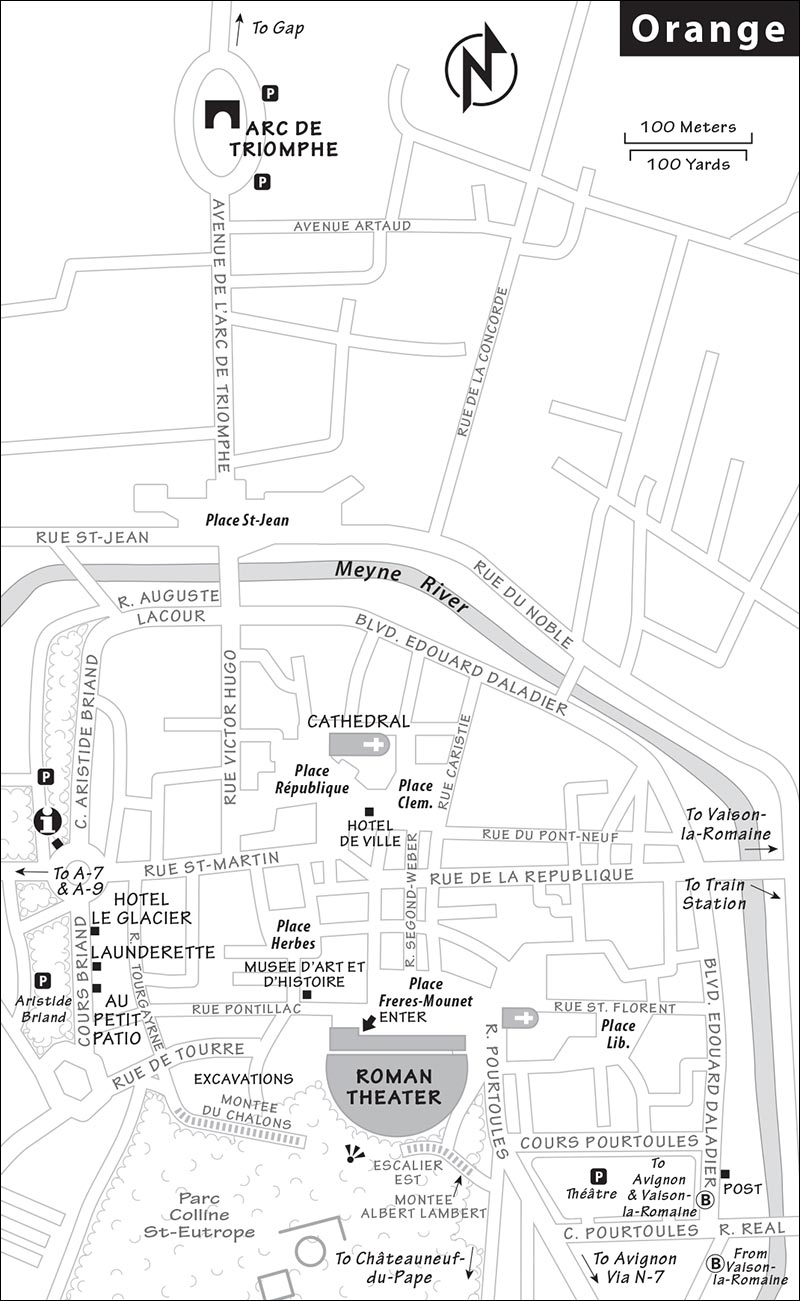
Video and Multimedia: In a passageway at the very top of the tiered seats, you’ll find a worthwhile 15-minute video history of the theater plus the amusing Ghosts of the Theater multimedia show, which covers four periods of performance history (including rock concerts).
Cheap Trick: Vagabonds wanting a partial but free view of the theater (or others wanting a view from above) can find it in the Parc de la Colline St-Eutrope. Walk around to the left of the theater (see the “Orange” map), and find the steps to the right, just after the tabac. Climb the steps, keep left at the first fork, and continue for a little over 100 yards, then take the steps to the right to the top. From here, follow the Point de Vue sign to the right. Benches and grassy areas make this a good picnic spot (no WCs), and you can scamper about for views of the theater from different angles.
Visiting the Theater: If you pay to enter, to the right you’ll see a huge dig devoted to the Temple to the Cult of the Emperor (English explanations posted). But we’ll turn left, into the theater.
Climb the steep stairs to find a seat high up to appreciate the massive acoustical theater wall, one of the greatest surviving examples of Roman architecture. Contemplate the idea that 2,000 years ago, Orange residents enjoyed grand spectacles here, with high-tech sound and lighting effects—such as simulated thunder, lightning, and rain. If you’ve been to Arles’ Ancient History Museum, conjure up the theater model there and imagine this place covered with brilliant white marble.
From the center of the acoustic wall, a grandiose Caesar overlooks everything, reminding attendees of who’s in charge. If it seems like you’ve seen this statue before, you probably have. Countless identical sculptures were mass-produced in Rome and shipped throughout the empire to grace buildings like this for propaganda purposes. To save money on shipping and handling, only the heads of these statues were changed with each new ruler. The permanent body wears a breastplate emblazoned with the imperial griffon (body of a lion, head and wings of an eagle) that only the emperor could wear. When a new emperor came to power, new heads were made in Rome and shipped off throughout the empire to replace the pop-off heads on these statues. (Imagine Barack Obama’s head on George W. Bush’s body—on second thought...)
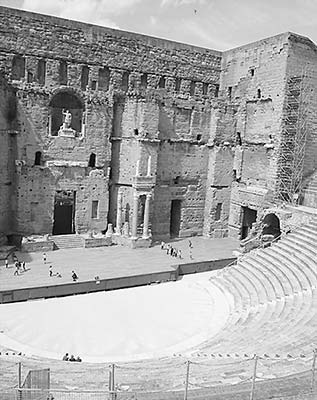
The horn has blown. It’s time to find your seat: row 2, number 30. Sitting down, you’re comforted by the “EQ GIII” carved into the seat (Equitas Gradus #3...three rows for the Equestrian order). You’re not comforted by the hard limestone bench (thinking it’ll probably last 2,000 years). The theater is filled with people. Thankfully, you mix only with your class, the nouveau riche—merchants, tradesmen, and city big shots. The people seated above you are the working class, and way up in the “chicken roost” section is the scum of the earth—slaves, beggars, prostitutes, and youth hostellers. Scanning the orchestra section (where the super-rich sit on real chairs), you notice the town dignitaries hosting some visiting VIPs.
OK, time to worship. Around the stage, they’re parading a bust of the emperor from its sacred home in the adjacent temple. Next is the ritual animal sacrifice called la pompa (so fancy, future generations will use that word for anything full of such...pomp). Finally, you settle in for an all-day series of spectacles and dramatic entertainment. All eyes are on the big stage door in the middle—where the Angelina Jolies and Brad Pitts of the day will appear. (Lesser actors use the side doors.)
With an audience of 10,000 and no amplification, acoustics were critical. A partial roof made of wood was originally suspended over the stage, somewhat like the glass-and-iron roof you see today (installed to protect the stage wall). The original was designed not to protect the stage from the weather, but to project the voices of the actors into the crowd (see if you can eavesdrop on people by the stage). For further help, actors wore masks with leather caricature mouths that functioned as megaphones. The theater’s side walls originally rose as high as the stage wall and supported a retractable awning (called a velarium) that gave the audience some protection from the sun or rain. (When you leave the theater, look up to the stage wall from the outside and notice the supports for poles that held the velarium in place, like the masts and sails of a ship.)
The Roman Theater was all part of the “give them bread and circuses” approach to winning the support of the masses. Its spectacles grew from 65 days of games per year when the theater was first built (and when Rome was at its height) to about 180 days each year by the time Rome finally fell.
Nearby: Pop into the Musée d’Art et d’Histoire across the street (included with ticket, free audioguide) to see a few theater details and a rare Roman land register, ordered by Emperor Vespasian in AD 79. Carved on marble, this was an official record of property ownership—each square represented a 120-acre plot of land. The fine mosaics and carvings displayed here humanize what are otherwise stony ancient ruins.
This 60-foot-tall arch is in the center of a pleasant traffic circle, a level 15-minute walk north of the theater. Technically the only real Roman arches of triumph are in Rome’s Forum, built to commemorate various emperors’ victories. But this arch was the model for those in Rome, preceding the famous arches of Septimius Severus and Constantine. It was erected in about AD 19 to commemorate the Roman general Germanicus and one of the bloodiest battles in the conquest of Gaul. The facade is covered with reliefs of military exploits, including naval battles and Romans beating up on barbarians and those rude, nasty Gauls. (Around the arch, you’ll find easy free parking and a picnic site.)
Orange owns a fine City Hall, worth the short detour to appreciate it (in the heart of the old town on Place Georges Clemenceau).
Sleeping: $ Hôtel le Glacier,*** across from the TI, is run by English-speaking and affable Philippe. It’s a good value, with easy parking, a comfortable lobby with a bar, and well-designed rooms (book directly for a free upgrade when available, elevator, air-con, a few parking spaces, 46 Cours Aristide Briand, tel. 04 90 34 02 01, www.le-glacier.com, info@le-glacier.com).
Eating: Orange has several inviting squares with ample eating choices in all price ranges. A few cafés/restaurants are across from the theater. You’ll find more choices by wandering the lanes toward the Hôtel de Ville. For a more refined meal, $$$ Au Petit Patio delivers elegant dining and fine cuisine (closed Wed-Thu and Sun, 58 Cours Aristide Briand, tel. 04 90 29 69 27).
From Orange by Train to: Avignon (hourly, 20 minutes), Arles (4/day direct, 35 minutes, more frequent with transfer in Avignon), Lyon (16/day, 2 hours).
By Bus to: Vaison-la-Romaine (bus #4, 10/day Mon-Sat, 2/day Sun, 1 hour), Avignon (bus #2, 14/day Mon-Sat, 3/day Sun, 45 minutes). For all bus service, check www.cars-lieutaud.fr or www.voyages-arnaud.com.
Buses to Vaison-la-Romaine and other wine villages depart from the train station and from Cours Pourtoules (see map on here). Because of occasional route changes, bus #4 to Vaison-la-Romaine may depart across from the bus shelter (look for blue bus icon or verify with any bus driver at the shelter).
The sunny Côtes du Rhône wine road—one of France’s most engaging—starts at Avignon’s doorstep and winds north along a mountainous landscape carpeted with vines, studded with warm stone villages, and carpeted with fields of fragrant lavender, all presided over by the wind-scarred Mont Ventoux. The wines of the Côtes du Rhône (grown on the côtes, or hillsides, of the Rhône River valley) are easy on the palate and on your budget, as are the area’s good-value restaurants. But this hospitable area offers lots more than wine—its hill-capping villages inspire travel posters, its Roman ruins add historical perspective, and the locals seem as excited about their region as you are.
If you’re sleeping in this area, Vaison-la-Romaine is a handy home base. It offers reasonable bus connections with Avignon and Orange, bike rental, and a mini Pompeii in the town center. To delve further into the region’s highlights, follow my driving tour of favorite wine villages, or pedal along peaceful roads to nearby towns. The vineyards’ centerpiece, the Dentelles de Montmirail mountains, are laced with hiking trails.
To explore this area, allow two nights for a decent dabble. Drivers should head for the hills (read this section’s self-guided driving tour before deciding where to stay). If you’re without wheels, Vaison-la-Romaine or Orange make the only practical home bases (or, maybe better, consider a minivan tour for this area).
By Car: Pick up Michelin maps #332 or #527. Landmarks like the Dentelles de Montmirail and Mont Ventoux help you get your bearings. I’ve described my favorite driving route in this region (“Côtes du Rhône Wine Road Drive”) near the end of this section.
By Bus: From Orange, buses run regularly to Vaison-la-Romaine and Avignon Monday to Saturday, though for most, taking the train from Avignon to Orange and then the bus to Vaison-la-Romaine is best. There’s only scant service between Orange and several of the wine villages described in this section (see “Orange Connections,” earlier, for details). All routes provide scenic rides through this area. A useful website for figuring out your bus options is www.pacamobilite.fr.
By Train: Trains from Avignon (hourly, 20 minutes) will get you as far as Orange (and bus connections).
By Minivan Tour: There’s no shortage of people willing to take you for a ride through this marvelous region—so buyer beware. For my recommendations on wine-focused tours, more general tours, and private guides, see “Tours in Provence” on here.
With quick access to vineyards, villages, and Mont Ventoux, this lively little town of 6,000 makes a good base for exploring the Côtes du Rhône region. You get two villages for the price of one: Vaison-la-Romaine’s “modern” lower city has Roman ruins, a lone pedestrian street, and the lively, café-lined main square—Place Montfort. The car-free medieval hill town looms above, with meandering cobbled lanes, a handful of cafés and art galleries, and a ruined castle.
The city is split in two by the Ouvèze River. A Roman-era bridge connects the lower town (Ville-Basse) with the hill-capping medieval upper town (Ville-Haute).
The TI is in the lower city, between the two Roman ruin sites, at Place du Chanoine Sautel (July-Aug Mon-Fri 9:00-18:45, Sat-Sun 9:00-12:30 & 14:00-18:45; Sept-June Mon-Sat 9:30-12:00 & 14:00-17:45, Sun 9:30-12:00—except closed Sun mid-Oct-March; tel. 04 90 36 02 11, www.vaison-ventoux-tourisme.com). Say bonjour to the charmante and ever-so-patient staff, ask about festivals and other events, and pick up information on walks and bike rides.
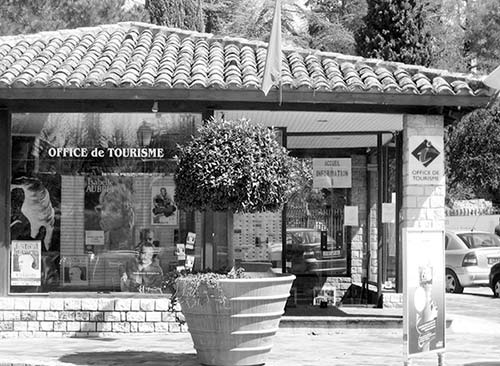
By Bus: Bus stops are near the Cave la Romaine winery on the edge of the lower town. Tell the driver you want the stop for the Office de Tourisme. When you get off the bus, walk five minutes down Avenue Général de Gaulle to reach the TI and recommended hotels.
By Car: Follow signs to Centre-Ville, then Office de Tourisme, and park in or near the big lot across from the TI. Parking is free in Vaison-la-Romaine.
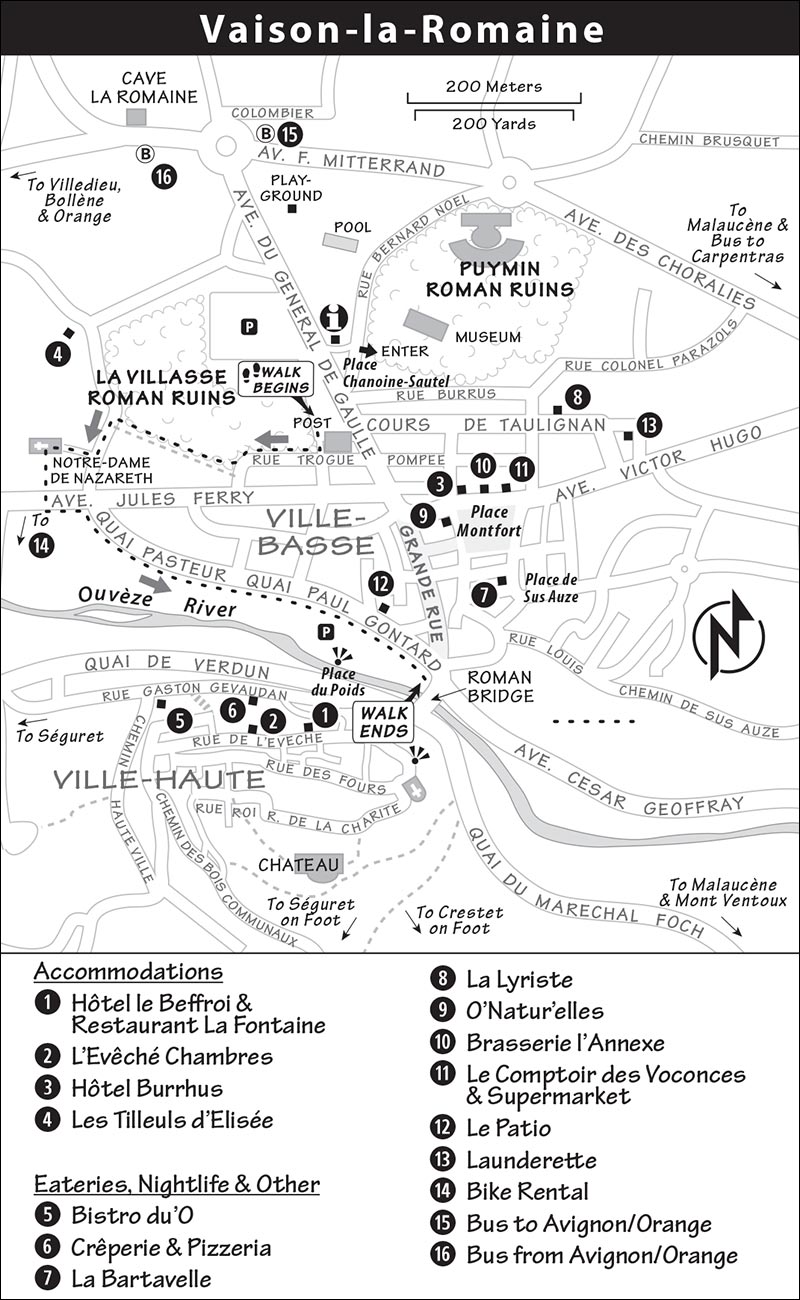
Market Day: Sleep in Vaison-la-Romaine on Monday night, and you’ll wake to an amazing Tuesday market. If you spend a Monday night, ask your hotelier where you can park—avoid parking at market sites and where signs indicate Stationnement Interdit le Mardi, or you won’t find your car where you left it.
Supermarket: A handy Casino is on Place Montfort in the thick of the cafés (Mon-Sat 7:30-13:00 & 15:30-19:30, Sun 9:00-13:00).
Laundry: The self-service Laverie la Lavandière is on Cours Taulignan, near Avenue Victor Hugo (daily 8:00-22:00, English instructions). The friendly owners, who work next door at the dry cleaners, will do your laundry while you sightsee (dry cleaners closed Sun).
Bike Rental: The TI has a list. Sun-e-bike is the most central, with electric and regular bikes (160 Avenue René Cassin, tel. 09 54 94 99 14, www.sun-e-bike.com). For help with bike rental and biking plans, contact John and Monique at the recommended L’Ecole Buissonnière Chambres (see listing under “Sleeping in Vaison-la-Romaine”).
Taxi: Call 04 90 36 00 04 or 04 90 46 89 42.
Car Rental: You can rent cars by the day, though they must be returned to Vaison-la-Romaine and supply is limited; ask at the TI for locations.
Local Guide: Scottish by birth and an attorney by profession, Janet Henderson offers enthusiastic and educational walks of Vaison-la-Romaine that bring those Roman ruins and medieval buildings to life (€30/person, minimum 3 people or €90, allow 2.5 hours, www.provencehistorytours.com, janet.henderson@wanadoo.fr).
Tourist Train: The Petit Train stops in front of the TI and does a 35-minute loop around the town (€5, free for kids under 12, daily July-Aug 10:00-17:00, Sept-June 14:00-17:00).
Cooking Classes: Charming Barbara Schuerenberg offers reasonably priced cooking classes from her view home in Vaison-la-Romaine, where you’ll pick herbs from the garden to use in the recipes (€90, cash only, includes lunch, 4-person maximum, tel. 04 90 35 68 43, www.cuisinedeprovence.com, cuisinedeprovence@gmail.com).
After-Dinner Fun: You won’t party late in this quiet town but there are a few fun places to consider. Place Montfort has most of the action: Brasserie L’Annexe has the warmest interior, while Le Comptoir des Voconces is the happening hangout with a pub-like ambience. Below the Roman bridge, Le Patio has cool wine-bar action at the back of its restaurant (closed Wed and Sun, 4 Rue de Ventoux).
Vaison’s top sight is its Gallo-Roman ruins—Puymin and Villasse. Start your sightseeing day at the Puymin site, then follow my short self-guided walk to tie together the rest of Vaison’s sights. Pick up the detailed city map from the tourist office before you begin.
A modern road splits the town’s Gallo-Roman ruins into two well-presented sites, Puymin and La Villasse. The Puymin side has more to see and gives a good introduction to these ruins, thanks to its small museum offering a look at life during the Roman Empire (see below). For helpful background about Roman civilization, read “The Romans in Provence” on here.
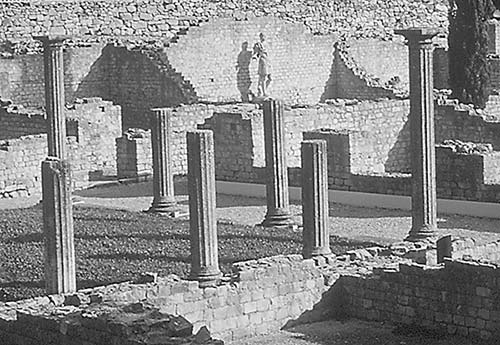
Cost and Hours: €9 ticket admits you to both sites; daily June-Sept 9:30-18:30, shorter hours off-season, closed Jan-Feb; good audioguide-€3, tel. 04 90 36 50 48, www.vaison-la-romaine.com.
Visiting the Puymin Ruins: Near the entry are the scant but worthwhile ruins of a sprawling mansion. Find the faint remains of a colorful frescoed wall and mosaic floors, as well as a few wells, used before Vaison’s two aqueducts were built. Climb the short hill to the good little museum (pick up your audioguide here; exhibits also well explained in an English loaner booklet). Artifacts include lead water pipes, well-preserved mosaic floors, and a few models of ancient buildings. Be sure to see the 12-minute film (plays in English every other showing) that takes you inside the homes and daily life of wealthy Vaison residents some 2,000 years ago. A five-minute walk behind the museum brings you to a largely rebuilt (but still used) 6,000-seat theater—just enough seats for the whole town (of yesterday and today).
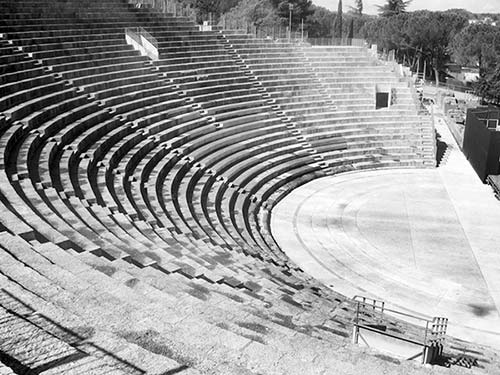
• Exiting the Puymin site will deposit you just above the TI—and the start of my self-guided walk, next.
Give yourself 45 minutes for this level, crosstown ramble. We’ll start just across from the TI, behind the post office. Lean against the railing there overlooking the Villasse archaeological site.
La Villasse Ruins: When the Romans took over Provence (second century BC), the people of Vaison-la-Romaine sided with their vanquishers, earning themselves a preferred “federated” relationship with Rome (rather than being a simple colony). This, along with a healthy farming economy (olives and vineyards) and good weather made it a most prosperous place...as a close look at these sprawling ruins demonstrates.
About 6,000 people called Vaison-la-Romaine home 2,000 years ago. The Roman town extended all the way from where you’re standing to the Ouvèze River (to the left, or south). The ancient forum lies between you and the river (not excavated). Vaison was a river port, boasting aqueducts, a big theater, baths, a forum, busy shopping streets, and the trophy homes of wealthy businessmen.
When the barbarians arrived in the fifth century AD, the Romans were forced out, and the townspeople fled from their unwalled, unprotected low neighborhoods into the hills. The town’s population has only recently recovered from those barbaric times, with the number of residents again reaching Roman-era levels.
If you have a ticket, you can walk through the Villasse ruins, though you can see everything from the sidewalks that run along the perimeter—which is our plan. What you can see between both Puymin and Villasse is only about 10 percent of the Roman town’s extent—most is still buried under today’s city.
Make your way to the corner of Rue Trogue Pompée, just behind the post office. The ruins sit behind a stone and iron fence that runs the length of the street. Stop in about 20 steps, just before reaching the tall arch. Spot the wire mesh that covers parts of a Roman sewer that was used until the 1900s. That tall arch was the centerpiece of a public Roman bath. Notice the public latrines a few steps farther along. That stone channel in front of the toilets had running water that men used to rinse the public sponge (usually attached to a stick—before the invention of toilet paper). Hmmm.
The stone-paved street running perpendicularly below you was lined with shops. The columns and remnants on the left side are what’s left of two mega-homes. You won’t see the homes of poorer folks as they were built from materials that did not last.
Continue along the pedestrian walkway that hugs the ruins. Just below, find an original (if faded) mosaic under a tiled roof. Nearby, there’s a linear channel that was once lined in marble and used as a fish pond (some parts of it are now planted).
• Turn left as you leave the ruins behind. You’ll pass a lovely garden, then turn right at the first little path you come to. Stop when you reach the back of...
Notre-Dame de Nazareth Cathedral: As you approach this medieval church, look at its base to find the stubs of Roman columns that form its foundation. This church wasn’t built until 600 years after the Romans left, thanks to a lack of security in the lower town and a complete loss of Roman-era building techniques. The first church built over the Roman ruins was abandoned in the Middle Ages, when residents fled to the relative safety of the upper town; the present building dates from the 11th to 12th century.
Walk left, then right, to view the church from its side. Appreciate the simple exterior. This is a fine example of Romanesque architecture: heavy arches, few windows, and little exterior decoration. Notice the delicate frieze under the eaves.
• With your back to the church, walk out to the street and turn left on Avenue Jules Ferry, then veer right on Quai Louis Pasteur. After several blocks, angle through the parking lot and find a spot above the river.
Medieval Hill Town: Look up to the medieval village. From the fourth century onward, Vaison-la-Romaine was ruled by a prince-bishop. When the sitting prince-bishop came under attack by the count of Toulouse in the 12th century, he built the abandoned castle you see on the top of this rocky outcrop (about 1195). Over time, the townspeople followed, vacating the lower town and building their homes behind the upper town’s fortified wall—where they would remain until after the French Revolution. The castle, which the count of Toulouse successfully claimed, protected the town for a while, but the count was eventually chased out by the armies of a Cathar-hating pope and a land-grabbing French king. The bell tower crowned by a lovely 18th-century wrought-iron bell cage (beautiful at night) tolled to announce curfew (the hill town was sealed tight after-hours), to warn of danger, or to signal important public events.
• Continue along the river to the corner of the parking area closest to the Roman bridge.
Roman Bridge: The Romans cut this sturdy, no-nonsense vault into the canyon rock 2,000 years ago, and it has survived ever since. Until the 20th century, this was the only way to cross the Ouvèze River. A vicious 1992 flood crested well above the bridge, and locals still talk of how water flowed through the windows and doors of the buildings on your left. The flood destroyed several other modern bridges downstream, but couldn’t budge the 55-foot Roman arch supporting the bridge.
• Exit the parking lot, turning right, and make your way to the bridge.
Read the information panel on the left side of the bridge, then find the small dark plaque (Septembre 22-92...) on the wall to the right, showing the high-water mark of the record flood that killed 30 people. A 50-yard detour down the road (with the river to your right) leads to fun views of the hill town’s rock-hugging Catholic church (it replaced Notre-Dame de Nazareth when folks fled the lower town).
• Our walk is over. From here, you have two choices: Explore the medieval lanes of the upper town, or meander the shops and main square of the lower town.
Upper Town (Ville-Haute): To reach the upper town, hike across the Roman bridge and up to the right (passing a WWI memorial), looping around and through the medieval gate, under the lone tower. Although there’s nothing of particular importance to see in the medieval town, the cobbled lanes and enchanting fountains make you want to break out a sketchpad. Look for occasional English information plaques as you meander. The château itself is closed, and the view from the steep, uneven trail to its base does not merit the effort.
Lower Town (Ville-Basse): To reach Place Montfort, the TI, and the main parking lots, from the Roman bridge do an about-face and walk up the pedestrian-only Grande Rue, Vaison’s main shopping street. The modern town centers on café-friendly Place Montfort. Tables grab the north side of the square, conveniently sheltered from the prevailing mistral wind while enjoying the generous shade of the ubiquitous plane trees.
Cave la Romaine, a five-minute walk up Avenue Général de Gaulle from the TI, offers a big variety of good-value wines from nearby villages in a pleasant, well-organized tasting room (free tastes, Mon-Sat 9:00-12:30 & 14:00-18:30, Sun 9:00-12:00, Avenue St-Quenin, tel. 04 90 36 55 90, www.cave-la-romaine.com).
Stop at the TI for detailed information on hikes into the hills above Vaison-la-Romaine.
It’s about 1.5 hours to the quiet hill town of Crestet, though views begin immediately. To find the trail, drive or walk on Chemin des Bois Communaux, the road behind the castle in the upper town (with the rock base and castle on your left), continue onto Chemin des Fontaines (blue signs), and stay the course as far as you like (follow yellow Crestet signs). Cars are not allowed on the road after about a mile.
To find the five-mile trail to Séguret (allow 2 hours), take the same road above Vaison-la-Romaine and look for a yellow sign (Sablet/Coste Belle) to the right. For either route, consider hiking one way and taking a taxi back (best to arrange a pickup in advance in Vaison-la-Romaine—ask your hotelier).
The TI has details on several manageable bike routes, with good directions in English, as well as information on mountain-biking trails (also available at bike shops). The easiest is the yellow itinerary to Séguret and Sablet (shortcuts back to Vaison are described, allowing for loop rides of one to three hours). If the air’s calm, the five-mile ride to cute little Villedieu (with the recommended La Maison Bleue restaurant) is a delight. The bike route is signed along small roads; from Vaison-la-Romaine, find the road to Villedieu at the roundabout by Cave La Romaine (see “Vaison-la-Romaine” map). Alternatively, get a good map and connect the following villages for an enjoyable 11-mile loop ride: Vaison-la-Romaine, St-Romain-en-Viennois, Puyméras, Faucon, and St-Marcellin-lès-Vaison.
Hotels in Vaison-la-Romaine are a good value and are split between the upper medieval village (with all the steps) and the lower main town (with all the services). Those in the upper village (Ville-Haute) are quieter, cozier, cooler, and give you the feeling of sleeping in a hill town (some come with views), with all the services of a real town just steps away. But they require a 10-minute walk down to the town center and Roman ruins. None of the hotels listed has an elevator, and few have air-conditioning.
If you have a car, consider staying in one of the Côtes du Rhône villages near Vaison-la-Romaine. I’ve listed a few nearby places here; for more suggestions see the “Côtes du Rhône Wine Road Drive,” later.
If staying in the upper village with a car, follow signs to Cité Médiévale and park just outside the upper village entry (driving into the Cité Médiévale itself is a challenge, with tiny lanes and nearly impossible parking).
$$ Hôtel le Beffroi*** hides deep in the upper town, just above a demonstrative bell tower (which stops demonstrating at 22:00). The hotel offers 16th-century red-tile-and-wood-beamed-cozy lodgings with nary a level surface. The rooms—split between two buildings a few doors apart—are Old World comfy, and some have views. You’ll enjoy antique-filled public spaces, a view-filled garden, a small pool with more views, and animated Nathalie at reception (several good family rooms, closed mid-Jan-March, Rue de l’Evêché, tel. 04 90 36 04 71, www.le-beffroi.com, hotel@le-beffroi.com). The hotel has a $$$ restaurant with pleasant outdoor seating in fine weather (see “Eating in Vaison-la-Romaine,” later).
$ L’Evêché Chambres, a few doors away from Hôtel le Beffroi, is a five-room melt-in-your-chair B&B. The charming owners (the Verdiers) have an fine sense of interior design and are passionate about books, making this place feel like a cross between a library and an art gallery (the solanum suite is worth every euro, Rue de l’Evêché, tel. 04 90 36 13 46, eveche.free.fr, eveche@aol.com).
$ Hôtel Burrhus** is equal parts contemporary art gallery and funky-creaky hotel—but a good value. It’s a central, laid-back place, with a broad, terrific terrace over Place Montfort and surprisingly big rooms (for maximum quiet, request a back room). Its floor plan will confound even the ablest navigator (air-con, 1 Place Montfort, tel. 04 90 36 00 11, www.burrhus.com, info@burrhus.com).
$ Les Tilleuls d’Elisée is a terrific chambres d’hôte in a stone, blue-shuttered home near the Notre-Dame de Nazareth Cathedral, 10 minutes’ walk below the TI. Anne and Laurent Viau run this comfortable five-room place with grace and great rates. Relax in the garden with views to the upper town and ask about wine tastings in their small cellar (includes breakfast, air-con, 1 Avenue Jules Mazen, tel. 04 90 35 63 04, www.vaisonchambres.info, anne.viau@vaisonchambres.info).
$ L’Ecole Buissonnière Chambres is run by an engaging Anglo-French team, John and Monique, who share their peace and quiet 10 minutes north of Vaison-la-Romaine. This creatively restored farmhouse has three character-filled rooms and comfy public spaces. Getting to know John, who has lived all over the south of France, is worth the price of the room. The outdoor kitchen allows guests to picnic in high fashion in the tranquil garden (family rooms, includes breakfast, cash only; between Villedieu and Buisson on D-75—leave Vaison following signs to Villedieu, then follow D-51 toward Buisson and turn left onto D-75—Route de Villedieu; tel. 04 90 28 95 19, www.buissonniere-provence.com, ecole.buissonniere@wanadoo.fr).
Vaison-la-Romaine offers a handful of good dining experiences—arrive by 19:30 in summer or reserve ahead, particularly on weekends. And while you can eat very well on a moderate budget in Vaison, it’s well worth venturing to nearby Côtes du Rhône villages to eat. I’ve listed three nearby places; for recommendations farther afield, see the “Côtes du Rhône Wine Road Drive,” later. Wherever you dine, begin with a fresh glass of Muscat from the nearby village of Beaumes-de-Venise.
(See “Vaison-la-Romaine” map.)
$$$ Restaurant La Fontaine, located at the recommended Hôtel le Beffroi, serves traditional cuisine of average quality in the lovely hotel gardens when the weather agrees, and in the pleasant dining room when it doesn’t. If they’re serving in the garden, you won’t find a better setting in Vaison (closed Wed, tel. 04 90 36 04 71).
$$$ Bistro du’O dishes up creative and well-presented Franco-Provençal cuisine in a smart, stone-arches-meet-wood-tables setting in the lower part of the Ville Haute (closed Sun-Mon, Rue Gaston Gevaudan, tel. 04 90 41 72 90).
$ You’ll also find a simple crêperie with a view deck and a decent pizzeria on the main street leading up to the old town. Both have indoor and outdoor seating, some views over the river, and cheap, basic food (good for families).
(See “Vaison-la-Romaine” map.)
$$ La Bartavelle, run by friendly Berangère, is a good place to savor traditional French cuisine, with tourist-friendly mix-and-match choices of local options. The €30 menu gets you four courses, including a great cheese tray; the €23 menu offers top-end main-course selections and dessert (excellent foie gras and seafood plate—assiette de pêcheur, closed Mon and Fri lunch, also closed Sun evening off-season; outside terrace, air-con, 5 Rue Camille Pelletan, tel. 04 90 36 02 16).
$$ La Lyriste is an unpretentious and intimate place to experience true Provençal cuisine, with Sandra taking your orders and her husband doing the cooking (closed Sun-Mon, 45 Cours Taulignan, tel. 04 90 36 04 67).
$$ O’Natur’elles is a sweet little place, especially for lunch. It’s ideal for vegetarians, but good for all persuasions as the all-organic dishes can be served with or without meat. The cuisine is delicious, but the place is small (closed Wed, open Sat for dinner—ask about other nights, reservations smart, 38 Place Montfort, tel. 04 90 65 81 67).
Cafés on Place Montfort: Come here for classic $$ café fare and to observe the daily flow of life in Vaison-la-Romaine. Outdoor tables are ideal but can come with smokers. The popular Brasserie l’Annexe is best, with a good selection of fine quality dishes ranging from big salads to tempting plats du jour (open daily).
$ La Maison Bleue, about four miles north of Vaison-la-Romaine on Villedieu’s delightful little square, serves good pizzas and salads with great outdoor ambience. Skip it if the weather forces you inside (March-Oct Thu-Sun open for lunch and dinner, closed Mon-Wed except July-Aug closed Mon only, tel. 04 90 28 97 02).
$ Auberge d’Anaïs, at the end of a short dirt road 10 minutes from Vaison-la-Romaine, is a fun Provençal experience, ideal for a relaxing lunch or dinner en plein air (not worth it in bad weather). Outdoor tables gather under cheery lights with immediate vineyard views and classic Provençal cuisine. Ask for a table sur la terrasse (daily, tel. 04 90 36 20 06). Heading east of Vaison-la-Romaine, follow signs to Carpentras, then St. Marcellin-lès-Vaison. Signs will guide you from there.
$$ La Fleur Bleue is a good find, serving fresh and local cuisine in a charming blue-shuttered farmhouse (open for lunch and dinner, closed Wed and Sun, reservations smart, Chemin du Sublon, a mile from Crestet on the road toward Malaucène, tel. 04 90 36 23 45, www.lafleurbleue.fr).
The most central bus stop is a few blocks up Avenue Général de Gaulle from the TI near the main winery, Cave la Romaine. Buses to Orange and Avignon stop on the winery side (see “Vaison-la-Romaine” map for location). Buses to Nyons, Crestet, and Carpentras depart from the bus station farther east on that road.
From Vaison-la-Romaine by Bus to: Avignon (#4 to Orange, transfer to #2, 10/day Mon-Sat, 2/day Sun, 1.5 hours—train from Orange is faster), Orange (bus #4, 10/day Mon-Sat, 2/day Sun, 1 hour), Nyons (3-5/day, none on Sun, 45 minutes), Crestet (lower village below Crestet, bus #11, 5/day Mon-Sat, none on Sun, 5 minutes), Carpentras (bus #11, 5/day Mon-Sat, none on Sun, 1 hour).
(See “Côté du Rhône Driving Tour” map.)
This self-guided driving tour provides a crash course in Rhône Valley wine, an excuse to meet the locals who make the stuff, and breathtaking scenery—especially late in the day, when the famous Provençal sunlight causes colors to absolutely pop. Allow at least a half-day for this 35-mile loop drive, which starts in the village of Séguret, skirts Vaison-la-Romaine, and then winds clockwise around the Dentelles de Montmirail, visiting the mountaintop village of Crestet, adorable little Suzette, and the renowned wine villages of Beaumes-de-Venise and Gigondas. (You can, of course, start anywhere along this circular route.)
Even if wine isn’t your thing, don’t miss this scenic drive. This region is not only about wine; you’ll pass orchards of apricots, figs, and cherries, as well fields of table grapes. As you drive, notice how some vineyards grow at angles—they’re planted this way to compensate for the strong effect of the mistral wind.
Planning Your Drive: Our tour starts a bit south of Vaison-la-Romaine in little Séguret. By bike, or for a more scenic drive from Vaison-la-Romaine, cross to the Cité Médiévale side of the river, then follow D-977 signs downriver to Séguret (park in lots P-2 or P-3). Theft is a problem in this beautiful area—leave absolutely nothing in your car.
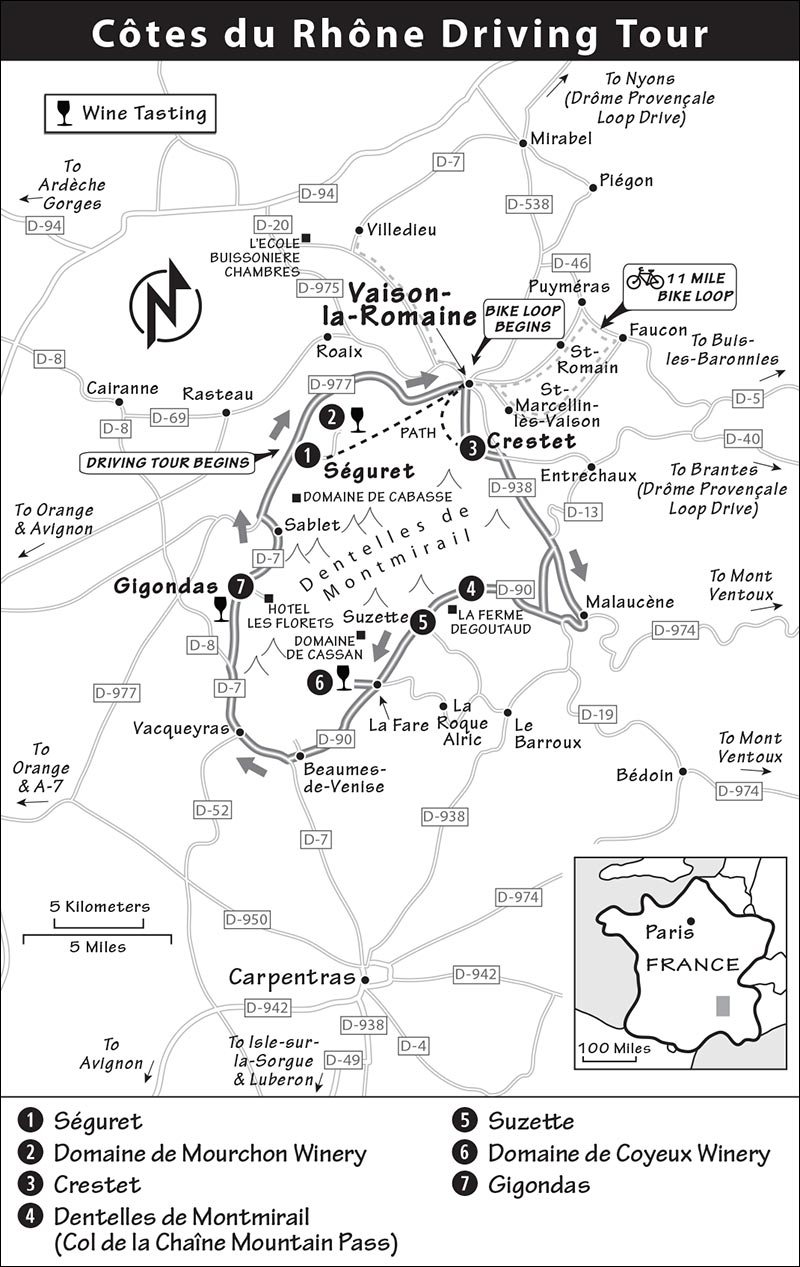
Wineries: I’ve listed several wineries (domaines) along the way. Remember that the wineries you’ll visit are serious about their wines—and they hope that you’ll take them seriously, too. At private wineries, tastings are not happy-go-lucky chances to knock back a few glasses and buy a T-shirt with the property’s label on it. Show genuine interest in the wines, and buy some if you like it.
Eating: Drivers on this route can enjoy a wealth of country-Provençal dining opportunities in rustic settings (even within 15 minutes of Vaison-la-Romaine). It’s a great opportunity to experience rural France. All restaurants listed have some outdoor seating and should be considered for lunch or dinner.
Blending into the hillside with a smattering of shops, two cafés, made-to-stroll lanes, and a natural spring, this hamlet is understandably popular. Séguret makes for a good coffee or ice cream stop and has a good café-restaurant.
Séguret’s name comes from the Latin word securitas (meaning “security”). The town’s long bulky entry arch came with a massive gate, which drilled in the message of the village’s name. In the Middle Ages, Séguret was patrolled 24/7—they never took their securitas for granted. Find the drawing of the medieval town with its high-flying castle on the arch’s wall. A castle once protected Séguret, but all that’s left today is a tower that you can barely make out (though trails provide access).
Walk through the arch and up a block. To appreciate how the homes’ outer walls provided security in those days, drop down the first passage on your right (near the fountain). These tunnel-like exit passages, or poternes, were needed in periods of peace to allow the town to expand below. You will come across La Maison d’Eglantine tucked in here, serving delicious cakes, coffee, and tea in a cozy room with views.
Moving along, you could follow Rue Calade up to the unusual 12th-century St. Denis church for views (the circular village you see below is Sablet). We’ll veer right and down instead, aiming for the santon shop (worth a peek for its displays). At Christmas, this entire village transforms itself into one big crèche scene. From here, drop down and return to your car past the recommended Restaurant/Café Côté Terrasse.
Sleeping and Eating: Sure, it’s a hotel and restaurant, but winemaking is also part of the business at $$ Domaine de Cabasse,*** a lovely spread flanked by vineyards at the foot of Séguret (with views and a walking path to the village). Free tastings are offered every evening from April through September. Each of the 23 rooms has tasteful decor, air-conditioning, and views over vines; all the first-floor rooms have balconies or decks (elevator, big heated pool, discount for 2-3 night stay if reserved directly with hotel; on D-23 between Sablet and Séguret, entry gate opens automatically...and slowly, tel. 04 90 46 91 12, www.cabasse.fr, hotel@cabasse.fr). It’s worth booking ahead for their $$ classy country restaurant.
$ Le Bouquet de Séguret Chambres d’Hôte is a lovely Provençal refuge perched just above Séguret with vineyard and village views, a pool, and owners Jos and Ingrid—who spoil their guests with optional home-cooked dinners, wine tastings, and afternoon tea (near Domaine de Cabasse at 252 Route de Sablet, tel. 04 90 28 13 83, www.lebouquetdeseguret.com, info@lebouquetdeseguret.com).
With a terrific setting in the center of the village, $$ Restaurant/Café Côté Terrasse offers all-day café service as well as lunch and dinners. They deliver big portions, reasonable prices, good quality, and cheerful service, either on the terrace or in the modern interior (daily from 10:00, Rue des Poternes, tel. 04 90 28 03 48).
• Signs near Séguret’s upper parking lots lead you up, up, and away to our next stop, the nearby Domaine de Mourchon (leave bread crumbs or track your route up to find your way back down).
This high-flying winery blends state-of-the-art technology with traditional winemaking methods (a shiny ring of stainless-steel vats holds grapes grown on land plowed by horses). The wines have won the respect of international critics. Take advantage of the amazing deal they’ve arranged to deliver wine stateside for nearly the same price you’d pay at the winery. Free and informative English tours of the vineyards are usually offered on Wednesdays at 17:00, followed by a tasting, though you’re welcome to taste anytime they’re open (winery open Mon-Sat 9:00-18:00, Sun by appointment only; from Easter-Oct, call to verify; tel. 04 90 46 70 30, www.domainedemourchon.com).

• Next, drop back down to Séguret, head toward Vaison-la-Romaine, and once past the city follow signs for Carpentras/Malaucène. After passing through “lower” Crestet on the main highway, look for signs for a side road leading up to Le Village. Drivers can park at the second lot on the approach to the town, then hike up through the village on foot, or bypass the lower lots to keep climbing toward Place du Château at the top of town.
This quiet village—founded after the fall of the Roman Empire, when people banded together in high places like this for protection from marauding barbarians—followed the usual hill-town evolution. The outer walls of the village did double duty as ramparts and house walls. The castle above (from about 850) provided a final safe haven when the village was attacked.
Wander the peaceful lanes and appreciate the amount of work it took to put these stones in place. Notice the elaborate water channels. Crestet was served by 18 cisterns in the Middle Ages. Imagine hundreds of people living here with animals roaming everywhere. The bulky Romanesque church is built into the hillside; if it’s open, peek in to see the unusual stained-glass window behind the altar.
Eating: The village’s only business, the café-restaurant $$ Le Panoramic, well signed at the top of town, serves basic omelets, salads, crêpes, and plats from what must be Provence’s greatest view tables. Stop for a coffee or drink and enjoy the panorama (April-Nov daily 10:30-22:00, closed in bad weather and Dec-March, tel. 04 90 28 76 42).
Nearby: A fine lunch stop about a mile from Crestet is $$ La Fleur Bleue (see “Eating in Vaison-la-Romaine,” earlier).
• Drivers should carry on and reconnect with the road below, following signs to Malaucène. Entering Malaucène, turn right on D-90 (direction: Suzette) just before the gas station. After a few minutes you’ll approach a pass. Look for signs on the left to Col de la Chaîne (Chain Pass).
Get out of your car at the pass (elevation: about 1,500 feet) and enjoy the breezy views. The peaks in the distance—thrusting up like the back of a stegosaurus or a bad haircut (you decide)—are the Dentelles de Montmirail, a small range running just nine miles basically north to south and reaching 2,400 feet in elevation. This region’s land is constantly shifting. Those rocky tops were the result of a gradual uplifting of the land, which was then blown bald by the angry mistral wind. The village below the peaks is Suzette (you’ll be there soon).
Now turn around and face Mont Ventoux. Are there clouds on the horizon? You’re looking into the eyes of the Alps (behind Ventoux), and those “foothills” help keep Provence sunny.
• Time to push on. With the medieval castle of Le Barroux topping the horizon in the distance (off to the left), drive on to little...
Tiny Suzette floats on its hilltop, with a small 12th-century chapel, wine tastings, a handful of residents, and the gaggle of houses where they live. Park in Suzette’s lot, then find the big orientation board above the lot. Look out to the broad shoulders of Mont Ventoux. At 6,000 feet, it always seems to have some clouds hanging around. If it’s clear, the top looks like it’s snow-covered; if you drive up there, you’ll see it’s actually white stone.
Back across the road from the orientation table is a simple tasting room for Château Redortier wines (unreliable hours, but well-explained wine list provided). Good picnic tables lie just past Suzette on our route.
• Continue from Suzette in the direction of Beaumes-de-Venise. You’ll drop down into the lush little village of La Fare. Just after leaving the village is the...
A private road winds up and up to this impossibly beautiful setting, with the best views of the Dentelles I’ve found. Olive trees frame the final approach, and Le Caveau signs lead to a modern tasting room (you may need to ring the buzzer) within a big winery. The owners and staff are sincere and take your interest in their wines seriously—skip it if you only want a quick taste or are not interested in buying. These wines have earned their good reputation, and some are now available in the US (winery generally open daily 10:00-12:00 & 14:00-18:00, except closed Sun off-season and no midday closure July-Aug; tel. 04 90 12 42 42, www.domainedecoyeux.com, some English spoken).

• Drive on toward Beaumes-de-Venise. Navigate through Beaumes-de-Venise, following signs for Vacqueyras (a famous wine village with a Thursday market), and then signs for Gigondas and Vaison par la route touristique. As you enter Gigondas, follow signs to the TI and park on or near the tree-shaded square.
This upscale village produces some of the region’s best reds and is ideally situated for hiking, mountain biking, and driving into the mountains. The TI has lists of wineries and chambres d’hôtes, and tips for good hikes or drives (Mon-Sat 10:00-12:30 & 14:30-18:00, closed Sun, 5 Rue du Portail, tel. 04 90 65 85 46, www.gigondas-dm.fr). Take a short walk up through the village lanes to find a good viewing platform over the heart of the Côtes du Rhône vineyards (leaving from the recommended Du Verre à l’Assiette restaurant, veer right just after the Nez Bar à Vins, then make a quick left uphill); you’ll find even better views a little higher at the church.
Several good tasting opportunities lie on the main square. Le Caveau de Gigondas is the best, where Sandra and Barbara await your visit in a handsome tasting room with a large and free selection (daily 10:00-12:00 & 14:00-18:30, close to the TI on the main town square, tel. 04 90 65 82 29, www.caveaudugigondas.com). Here you can compare wines from 75 private producers in an intimate, low-key surrounding. The provided list of wines is helpful.
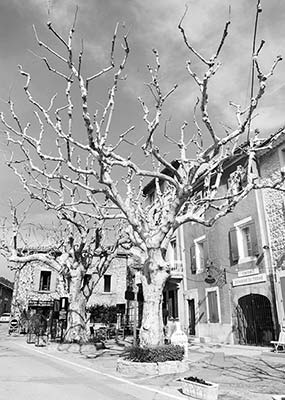
Sleeping and Eating: The shaded red tables of $$ Du Verre à l’Assiette (“From Glass to Plate”) entice lunchtime eaters, as does the good interior ambience (open for lunch daily except Wed, dinner Fri-Sat nights, and every night but Wed mid-June-mid-Sept, located diagonally across from TI, Place du Village, tel. 04 90 12 36 64). $ Nez Bar à Vins, with pleasant atmosphere inside and out, is a cool-if-trendy place to enjoy a glass of wine and light appetizers; you’ll find it along a pedestrian lane a block up from the main square (closed Sun-Mon, Place du Rouvis, tel. 04 90 28 99 59).
$$ Hôtel les Florets,*** with tastefully designed rooms, is a half-mile above Gigondas, buried in the foothills of the Dentelles de Montmirail. It comes with an excellent restaurant, a vast terrace with views, a pool, and hiking trails into the mountains (no air-con, annex rooms by pool have front patios, tel. 04 90 65 85 01, www.hotel-lesflorets.com, accueil@hotel-lesflorets.com). Their traditional, family-run $$$ restaurant is well worth the price—particularly if you dine on the magnificent terrace. Dinners blend classic French cuisine with Provençal accents, served with class by English-speaking Thierry. The weighty wine list is literally encyclopedic (closed Wed, also closed Thu for lunch, service can be slow).
• From Gigondas, follow signs to the circular wine village of Sablet—with generally inexpensive yet tasty wines (the TI and wine coopérative share a space in the town center)—then back to Séguret, where our tour ends.
Just 30 miles east of Avignon, the Luberon region hides some of France’s most captivating hill towns and sensuous landscapes. Those intrigued by Peter Mayle’s best-selling A Year in Provence love joyriding through the region, connecting I-could-live-here villages, crumbled castles, and meditative abbeys. Mayle’s book describes the ruddy local culture from an Englishman’s perspective as he buys a stone farmhouse, fixes it up, and adopts the region as his new home. A Year in Provence is a great read while you’re here—or, better, get it as an audiobook and listen while you drive.
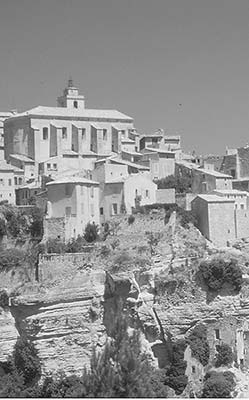
The Luberon terrain in general (much of which is a French regional natural park) is as enticing as its villages. Gnarled vineyards and wind-sculpted trees separate tidy stone structures from abandoned buildings—little more than rock piles—that challenge city slickers to fix them up. Mountains of limestone bend along vast ridges, while colorful hot-air balloons survey the scene from above.
There are no obligatory museums, monuments, or vineyards in the Luberon. Treat this area like a vacation from your vacation. Downshift your engine. Brake for views, and lose your car to take a walk. Get on a first-name basis with a village.
What follows is a rundown of my favorite villages and stops in this beautiful area. The D-900 highway cuts the Luberon in half like an arrow. The villages I describe sit just north and south of it.
By Car: Luberon roads are scenic and narrow. With no major landmarks, it’s easy to get lost—and you will—but getting lost is the point. Consider buying the Michelin map #332 or #527 to navigate, and look for free maps available at local TIs. Popular towns charge a small fee to park. Expect headaches parking in Isle-sur-la-Sorgue during its market days.
By Bus: Isle-sur-la-Sorgue is connected with Avignon’s town center by the Trans Vaucluse bus line #6 (12/day Mon-Sat, 2/day Sun, 45 minutes, central stop—called Robert Vasse—is near the post office in Isle-sur-la-Sorgue, ask for schedule at TI or download French-only schedule from www.voyages-raoux.fr/lignes/index.php). Buses also connect Isle-sur-la-Sorgue with the Marseille airport (4/day direct, 2 hours, www.info-ler.fr, look for Carpentras-Marseille line). Without a car or minivan tour, skip the more famous hill towns of the Luberon.
By Train: Trains get you to Isle-sur-la-Sorgue (station called “L’Isle-Fontaine de Vaucluse”) from Avignon (8/day on weekdays, 5/day on weekends, 30 minutes) or from Marseille (6/day, 1.5 hours). If you’re day-tripping by train, check return times before leaving the station.
By Minivan Tour: I list several minivan tour companies and private guides who can guide you through this marvelous region (see “Tours in Provence” on here).
By Taxi: Contact Luberon Taxi (based in Maubec off D-3, mobile 06 08 49 40 57, www.luberontaxi.com).
By Bike: Isle-sur-la-Sorgue makes a good base for biking, with level terrain and good rental options. Hardy bikers can ride from Isle-sur-la-Sorgue to Gordes, then to Roussillon, connecting other villages in a full-day loop ride (30 miles round-trip to Roussillon and back, with lots of hills). Several appealing villages are closer to Isle-sur-la-Sorgue and offer easier biking options. Sun-e-Bike rents electric bikes and has a network of partners with spare batteries scattered across the Luberon, extending the range of your e-bike trip. They can also arrange bike tours and shuttle your bags between hotels (1 Avenue Clovis Hugues in Bonnieux, tel. 04 90 74 09 96, www.sun-e-bike.com).
This sturdy market town—literally, “Island on the Sorgue River”—sits within a split in its crisp, happy little river at the foot of the Luberon. It’s a workaday town that feels refreshingly real after so many adorable villages.
Although Isle-sur-la-Sorgue is renowned for its market days (Sun and Thu), it’s an otherwise pleasantly average town with no important sights and a steady trickle of tourism. It’s lively on weekends but calm most weeknights. The town revolves around its river, the church square, and two pedestrian-only streets, Rue de la République and Rue Carnot.
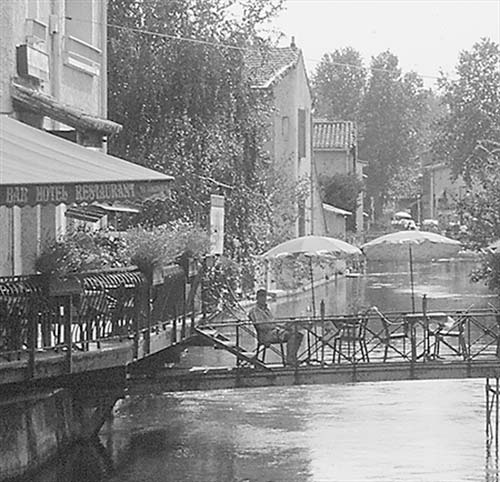
The TI has an essential town map, hiking information (ask about trails accessible by short drives), biking itineraries, and a line on rooms in private homes, all of which are outside town (April-Sept Mon-Sat 9:00-12:30 & 14:30-18:00, until 17:30 Oct-March, Sun 9:00-12:30; in town center next to church, tel. 04 90 38 04 78, www.oti-delasorgue.fr).
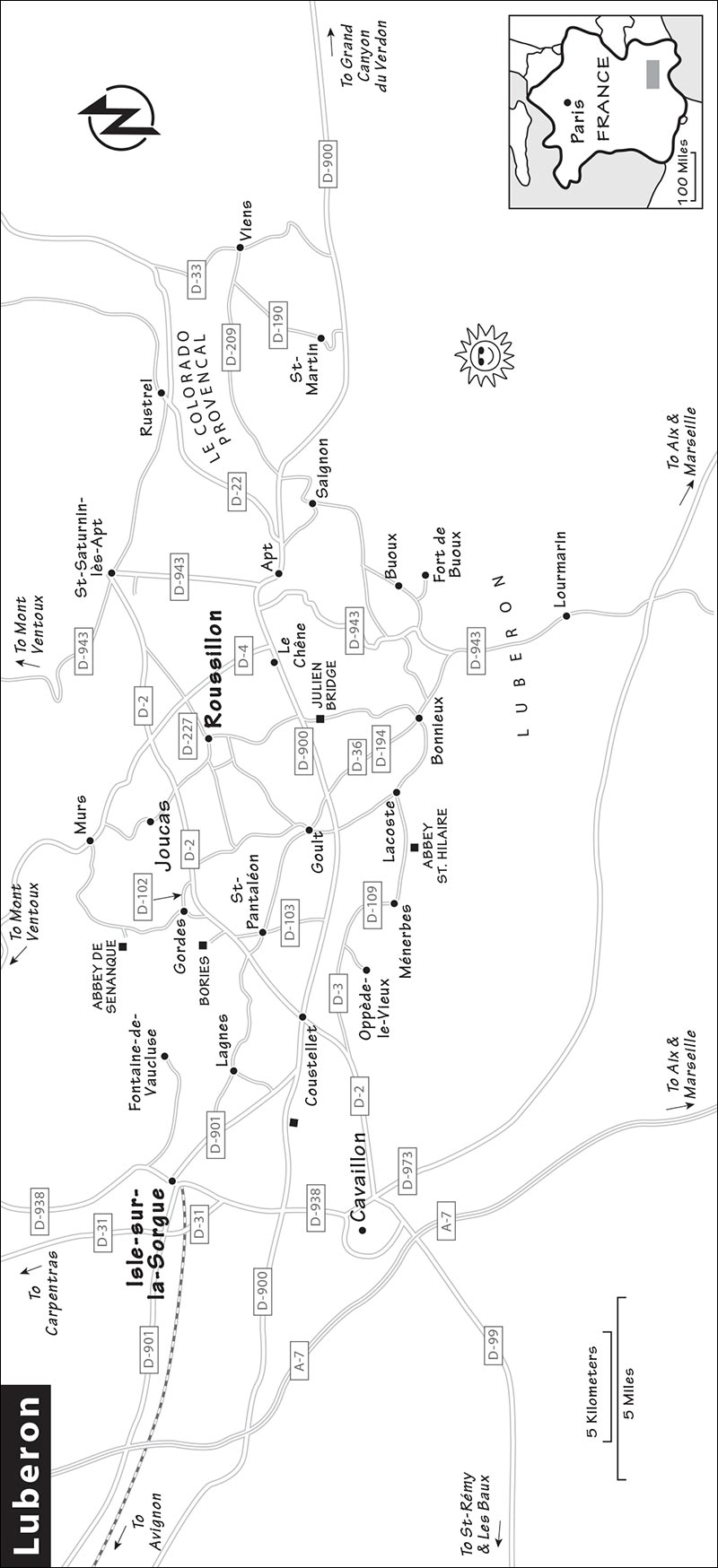
Visiting Isle-sur-la-Sorge: In Isle-sur-la-Sorgue—called the “Venice of Provence”—the Sorgue River’s extraordinarily clear and shallow flow divides like cells, producing water, water everywhere. The river has long nourished the region’s economy, but today, antique shops keep the town afloat. Navigate by the town’s splintered streams and nine mossy waterwheels, which, while still turning, power only memories of the town’s wool and silk industries. At its peak, Isle-sur-la-Sorgue had 70 waterwheels; in the 1800s, the town competed with Avignon as Provence’s cloth-dyeing and textile center.
Find Le Bassin, where the Sorgue River crashes into the town and separates into many branches (carefully placed lights make this a beautiful sight after dark).
With its source (a spring) a mere five miles away, the Sorgue River never floods and has a constant flow and temperature in all seasons. Despite its exposed (flat) location, Isle-sur-la-Sorgue prospered in the Middle Ages, thanks to the natural protection this river provided.
In the town’s center, peek into Notre-Dame des Anges church with its festive Baroque interior and colorful walls (closed 12:00-15:15). The town erupts into a carnival-like market frenzy each Sunday and Thursday, with hardy crafts and local produce. The Sunday market is astounding and famous for its antiques; the Thursday market is still impressive but focused more on produce and bric-a-brac than antiques.
Pickings are slim for good sleeps in Isle-sur-la-Sorgue, though the few I’ve listed provide reliable values. A laverie automatique (launderette) is in the town center, just off Rue de la République on Impasse de l’Hôtel de Palerme (open 24/7).
$$$ La Prévôté*** has the town’s highest-priced digs. Its five meticulously decorated rooms—located above a classy restaurant—are adorned in earth tones, with high ceilings, a few exposed beams, and carefully selected furnishings. Séverine manages the hotel while chef-hubby Jean-Marie controls the kitchen (includes breakfast, limited check-in/check-out times, no elevator, rooftop deck with hot tub, no parking, one block from the church at 4 Rue J. J. Rousseau, tel. 04 90 38 57 29, www.la-prevote.fr, contact@la-prevote.fr).
$$ Sous l’Olivier is 10 minutes from Isle-sur-la-Sorgue, off D-900 near Petit Palais. Here big Julien, quiet Carole, and sons Hugo and Clovis adopt you into their sprawling old stone farmhouse, with grass to burn, a big pool, yards of chairs and lounges, and views to the Luberon range. The six rooms are big but lack air-conditioning. A good breakfast is included, and the €34 dinner is a family affair, worth every euro (three apartments available, cash only, tel. 04 90 20 33 90, www.chambresdhotesprovence.com, souslolivier@orange.fr). Heading east on D-900, it’s near the village of Petit Palais, just after the David Ferronerie shop).
$ Hôtel les Névons,*** two blocks from the center (behind the post office), is concrete motel-modern outside, with well-priced and comfortable-enough rooms within, a roof deck with a small pool, and quick access to the town center (family rooms, air-con, elevator, free and safe parking, 205 Chemin des Névons, tel. 04 90 20 72 00, www.hotel-les-nevons.com, hotel-les-nevons@orange.fr). Easygoing Benjamin’s in charge.
$ Hôtel les Terrasses by David et Louisa** rents eight rooms over a pleasant restaurant right on Le Bassin. Several rooms look out over the river, most have some traffic noise and queen-size beds (air-con, 2 Avenue du Général de Gaulle, tel. 04 90 38 03 16, louisaetdavid@orange.fr).
Cheap and mediocre restaurants are a dime a dozen in Isle-sur-la-Sorgue. You’ll see several brasseries on the river, good for views and basic café fare.
For a cheap breakfast or a light riverside meal find $ La Passerelle, where charming Jennifer and Vincent serve salads, quiche, a plat du jour, and more (daily until 20:00, summers until 22:00, 18 Quai Jean Jaurès, mobile 06 62 18 23 57).
Begin your dinner with a glass of wine at the cozy wine and cheese shop $ Chez Stéphane. Or for a light meal, order a selection of cheeses from charming Stéphane (great to share) with your wine and call it good (wine barrel tables outside or find the bar hiding in the rear; daily 9:30-19:30, Fri-Sat until 21:00, 12 Rue de la République, tel. 04 90 20 70 25).
$$ Les Terrasses by David et Louisa is an appealing riverside wine-bar-bistro with a warm interior and ample choices. The cuisine is a blend of French traditional and Provençal (closed Wed, 2 Avenue du Général de Gaulle, tel. 04 90 38 03 16).
$$ Le Nego is a relaxed place with generous outdoor seating and a large selection of reasonably priced, regional fare that works well for riverfront dining (daily, 12 Quai Jean Jaurès, tel. 04 90 20 88 83).
$$$$ La Balade des Saveurs is a refreshing change from the many run-of-the-mill riverfront places. Here, the owners deliver fresh, fairly priced Provençal cuisine at riverside tables or in their elegantly sky-lit interior (closed Mon-Tue, 3 Quai Jean Jaurès, tel. 04 90 95 27 85, www.balade-des-saveurs.com).
$$$$ La Prévôté is the place in town to do it up in the elegant French style. Its lovely dining room is country-classy but not stuffy, and the cuisine blends traditional French with regional specialties. A stream runs under the restaurant, visible through glass windows (closed Tue, on narrow street that runs along left side of church as you face it, 4 Rue J. J. Rousseau, tel. 04 90 38 57 29, www.la-prevote.fr).
With all the trendy charm of Santa Fe on a hilltop, photogenic Roussillon requires serious camera and café time. An enormous deposit of ochre, which gives the earth and its buildings that distinctive reddish color, provided this village with its economic base until shortly after World War II. This place is popular; visit early while the rising sun highlights the ochre cliffs, or come late and stay for dinner.

The little TI is in the center, across from the Chez David restaurant. Say bonjour to sweet Pascale. Hotel hunters can leaf through their binders describing area hotels and chambres d’hôtes. Walkers should get info on trails from Roussillon to nearby villages (TI hours unreliable, usually Mon-Sat April-Oct 9:30-12:30 & 14:00-18:00, Nov-March 14:00-17:30, closed Sun year-round, Place de la Poste, tel. 04 90 05 60 25, http://otroussillon.pagesperso-orange.fr).
Parking lots are available at every entry to the village (free if you’re staying overnight and have arranged it with your hotel). Parking des Ocres (also called “P2”) is the largest lot on the hill toward the ochre cliffs. Day-trippers should head straight here, as spots are more available and the view of Roussillon is striking. Leave nothing of value visible in your car.
Parking Sablons is next to the recommended Maison des Ocres. Parking St-Michel is below the town on the way to Joucas and Gordes.
Visiting Roussillon: Climb from any parking lot to the village center, cross the cute square, and then climb under the bell tower and the church. Continue past the church to the summit and find the orientation table and the viewpoint. During the Middle Ages, a castle occupied this space on the top of the appropriately named Red Mountain (Mont Rouge), and watched over the village below.
Stroll back to the pretty 11th-century Church of St. Michel, and appreciate the natural air-conditioning and the well-worn center aisle.
Linger over un café, or—if it’s later in the day—un pastis, in the picturesque village square (Place de la Mairie). Watch the stream of shoppers. Is anyone playing boules at the opposite end? You could paint the entire town without ever leaving the red-and-orange corner of your palette. Many do. While Roussillon receives scads of day-trippers, mornings and evenings are romantically peaceful on this square.
Roussillon was Europe’s capital for ochre production until World War II. A stroll to the south end of town, beyond the upper parking lot, shows you why: Roussillon sits on the world’s largest known ochre deposit. Two radiant orange paths—the ▲▲ Ochre Cliffs Trail (Le Sentier des Ocres)—lead around the richly colored, Bryce Canyon-like cliffs; allow 35 minutes for the shorter path and 55 minutes for the longer one (€2.50, €7.50 combo-ticket with Ochre Conservatory—described next; May-June and Sept 9:30-18:30, July-Aug 9:00-19:30, shorter hours off-season, closed Jan).
For a good introduction to the history and uses of ochre, visit the ▲ Ochre Conservatory (Conservatoire des Ocres et de la Couleur), an intriguing reconstructed ochre factory. Grab a pamphlet to follow the well-done self-guided tour, which shows how ochre has been used since prehistoric times and how it is converted from an ore to a pigment—allow 45 minutes (€7, €7.50 combo-ticket with ochre cliffs, daily 9:00-18:00 but closed for lunch, July-Aug until 19:00, about a half-mile below Roussillon toward Apt on D-104, tel. 04 90 05 66 69, www.okhra.com).
The TI posts a list of hotels and chambres d’hôtes.
$$$ Le Clos de la Glycine*** delivers Roussillon’s plushest accommodations with nine lovely rooms located dead-center in the village (some view rooms, air-con, parking options, located at the recommended restaurant Chez David—they prefer you pay for half-pension, across from the TI on Place de la Poste, tel. 04 90 05 60 13, www.luberon-hotel.fr, contact@luberon-hotel.fr).
$$ Maison des Ocres,*** well-located on the edge of the village center at the Sablons parking area, is a stylish place with a spacious lounge, handsome, well-configured rooms (many with decks or balconies), a few good family rooms, and a lovely pool (private parking, Route de Gordes, tel. 04 90 05 60 50, www.lamaisondesocres-hotel.com, contact@lamaisondesocres-hotel.com). Coming from Gordes and Joucas, it’s the first building you pass in Roussillon.
$$$ Hôtel la Clé des Champs,*** more like an elegant bed-and-breakfast, is a lovely nine-room Provençal splurge warmly run by René and Armelle. Carefully appointed rooms are clustered about a heated pool, there’s a hammam and hot tub, and dinners are available several days each week for €38 (between Roussillon and Joucas, off D-2 on Chemin du Garrigon, tel. 04 90 05 63 22, www.hotelcledeschamps.com, contact@hoteldeschamps.com)
$$ At Le Mas Destonge, Stéphane and Dominique welcome you into their impeccable Provençal retreat located in a small neighborhood 10 minutes from Roussillon. Their five beautifully decorated rooms come with cozy lounges, a sweet patio, a common kitchen, and a big pool (on D-227 in Hameau Des Riperts, tel. 04 90 05 63 13, www.destonge.com, destonge@gmail.com).
$$ Hôtel les Sables d’Ocre** offers 22 well-maintained, motel-esque rooms, a big pool, the greenest grass around, air-conditioning, and fair rates (a half-mile from Roussillon toward Apt at intersection of D-108 and D-104, tel. 04 90 05 55 55, www.sablesdocre.com, sablesdocre@orange.fr).
$ Le Clos des Cigales is a good forested refuge run by friendly Philippe. Of their five blue-shuttered, stylish bungalows, two are doubles and three are two-room family friendly suites with tiny kitchenettes; all have private patios facing a big pool (family rooms, includes breakfast, table tennis, hammock, 5 minutes from Roussillon toward Goult on D-104, tel. 04 90 05 73 72, www.leclosdescigales.com, philippe.lherbeil@wanadoo.fr).
Located in the center of lovely little Joucas, $ Hostellerie des Commandeurs** has quite comfortable, good-value rooms and is kid-friendly, with a big pool and a sports field/play area next door. Ask for a south-facing room (côté sud) for the best views. All rooms have showers, air-conditioning, and mini fridges (above park at village entrance, hotel open March-Oct, tel. 04 90 05 78 01, www.lescommandeurs.com, hostellerie@lescommandeurs.com). The traditional $$ restaurant offers Provençal cuisine at fair prices (restaurant closed Wed). Village kids like to hang out around the bar’s pool table.
Restaurants change with the mistral here—what’s good one year disappoints the next. But I have found a few reliable places that offer a good range of prices and cuisine. Consider my suggestions, then go with what looks best.
A good place to splurge is at $$$$ Chez David, at the recommended hotel Le Clos de la Glycine. You can enjoy a fine meal on the terrace or from an interior window table with point-blank views over the ochre cliffs (daily, Place de la Poste, tel. 04 90 05 60 13).
$$ La Treille hangs just above the village square and serves good-value meals on a small terrace or under soft arches in an upstairs room. Souris d’agneau—lamb shank—is the chef’s specialty, though his daily specials are also worth considering (best to book ahead for an outside table, closed Wed, Rue du Four, tel. 04 90 05 64 47).
$ Le Bistrot de Roussillon is ideally situated on Roussillon’s delightful square and serves simple café fare at good prices. Dine at outdoor tables on the square (my favorite), inside in a pleasant dining room, or on a small terrace out back with views to the ochre cliffs (daily, Place de la Mairie, tel. 04 90 05 74 45).
$ Chez Nino cascades down the hillside with three view terraces. The chef is Sicilian and his wife is Moroccan, and the simple fare combines elements of both with regional cuisine (lunch or early dinner only, daily until 19:00, a block behind the TI on Rue des Bourgades, tel. 04 90 74 29 17).
I’d make a loop out of these villages and sights, doing them in the order described below. If you’re sleeping in or near Roussillon, start there (mornings are peaceful) then follow signs to Gordes, then Oppède-Le-Vieux, and so on (making a counterclockwise loop through the Luberon). If you’re staying elsewhere (like Isle-sur-la-Sorgue), start with Gordes, then Oppède-le-Vieux (ending with Roussillon). Bonnieux looks best from a distance, but it’s a good place for lunch or to stay overnight. Each town is about a 10-minute drive from the last and the route is well signed.
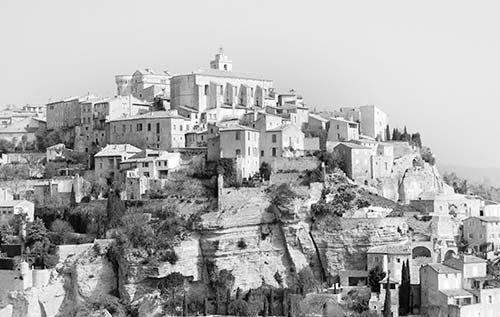
The Luberon’s most impressively situated hill town is worth a quick stop to admire its setting. As you approach Gordes, veer right when you see the viewpoint icon. Get out, stroll along the road, and admire the sensational view. Now consider this: In the 1960s Gordes was a ghost town of derelict buildings with no economy. Today Gordes is renovated top to bottom (notice how every stone seems perfectly placed) and filled with people who live in a world without calluses. Many Parisian big-shots and moneyed foreigners invested heavily, restoring dream homes and putting property values and café prices out of sight for locals. Beyond its stunning views, the village has pretty lanes lined with trendy boutiques and restaurants but little else of interest.
This still-functioning and beautifully situated Cistercian abbey was built in 1148 as a back-to-basics reaction to the excesses of Benedictine abbeys. Come first thing and stop at a pullout for a bird’s-eye view as you descend from Gordes, then wander the abbey’s perimeter. The abbey church is always open and free (except during Mass, but you’re welcome to attend) and highlights the utter simplicity sought by these monks. In late June through much of July, the five hectares of lavender fields that surround the abbey make for breathtaking pictures and draw loads of visitors.
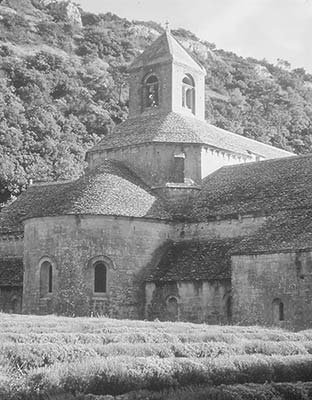
Abbey interior areas that you can visit include Sénanque’s church, the small cloisters, the refectory, and a chauffoir, a small heated room where monks could copy books year-round. The interior, which doesn’t measure up to the abbey’s spectacular setting, is a letdown—skip the tour and just wander the grounds.
Cost and Hours: €7.50 with or without a tour. French-only tours are mandatory daily 11:00-17:00, but individual visits are allowed Mon–Sat 9:00-11:00, or you can attend Mass at various times in the abbey’s church. There are no individual visits on Sunday or holidays, and no visits at all 12:45-14:30. Reservations for tours are recommended (English booklet with translations available, see website for times, tel. 04 90 72 05 72, www.senanque.fr, visites@ndsenanque.net). Modest dress is required for entry—shoulders and knees must be covered.
This off-the-beaten-path fixer-upper of a village was completely abandoned in 1910, and today has a ghost town-like feel (it once housed 200 people). Climb the 20-minute path up to the small church and castle ruins for views. Back down in the village center, consider a meal with views of the castle ruins at $ Le Petit Café, where all-business Laurent is in charge (closed Wed and mid-Dec-Feb). Le Petit Café also offers simple but comfy $ rooms, all with nice views (usually closed for check-in Tue-Wed, includes breakfast, air-con, rooftop terrace, tel. 04 90 76 74 01, www.lepetitcafe.fr, info@lepetitcafe.fr).
Ménerbes, still (in)famous as the village that drew author Peter Mayle’s attention to this region, has an upscale but welcoming feel in its small center (small parking fee). Wine bars, cafés, and a smattering of galleries gather where key lanes intersect. To explore the linear rock-top village, follow Eglise signs.
Find $$$$ Maison de la Truffe et du Vin, which offers “truffle discovery workshops,” fine meals, and wine tastings (Place de l’Horloge, tel. 04 90 72 38 37, www.vin-truffe-luberon.com). Pass the Hôtel de Ville for more views (the church is closed but the views aren’t) then double back and find Rue Corneille, which leads to the town’s cute château (closed to public). Find the even cuter prison room outside the château and walk back along the path.
A fine lunch or snack awaits at the $ Auzet Salon de Thé, with a cozy interior or view tables from the small terrace. You’ll find cheap quiche and savory pies with salad, delicious baked goods, and more (52 Rue du Portail Neuf, tel. 04 90 72 37 53).
Little Lacoste slumbers across the valley from Bonnieux in the shadow of its looming castle. This town is worth a stop to wander its pretty lanes to the base of the castle for views and to stop for a meal at $ Café de France, with its outdoor tables overlooking Bonnieux (reasonably priced omelets, quiche, and plats; daily, lunch only off-season, tel. 04 90 75 82 25).
Spectacular from a distance, this town lacks a pedestrian center, though the Friday-morning market briefly creates one. The main reason to visit here is to enjoy the views from a well-positioned restaurant or hotel.
Sleeping: Located in Bonnieux’s center, $$ Hôtel le Clos du Buis*** is a 10-room delight, run by eager-to-please Lydia and Sophie. Rooms are lovingly decorated—some have private decks, their veranda allows fine views over the Luberon, and the garden pool is a peaceful retreat (includes breakfast, air-con, free parking, guest kitchen, in the middle of town on Rue Victor Hugo, tel. 04 90 75 88 48, www.leclosdubuis.fr, contact@leclosdubuis).
The country-elegant chambres d’hôte $$$ Mas del Sol, between Bonnieux and Lacoste, is perfect for connoisseurs of the Luberon. Young Lucine and Richard Massol rent five bright, spacious rooms that come with views, vines, olives, and a big breakfast. The setting is unbeatable, and the stylish pool and gardens will knock your socks off (guest kitchen for family picnics, €40 three-course dinners with wine and coffee possible, tel. 04 90 75 94 80, www.mas-del-sol.com, contact@mas-del-sol.com). From D-900, take the D-36 turnoff to Bonnieux and look for Mas del Sol signs on the right after about three kilometers (two miles).
Eating: To eat with a view, find $ Les Terrasses, serving basic café cuisine on a sensational view terrace at the top of the village (open daily for lunch and dinner, Cours Elzéar Pin, tel. 04 90 75 99 77). To dine in Provence elegance sans view, find $$$ Restaurant l’Arôme with a formal-but-warm dining room and a streetside terrace, (closed Wed, across from Hôtel le Clos du Buis at 2 Rue Lucien Blanc, tel. 04 90 75 88 62).

Due south of Roussillon, just below D-900 (see “Luberon” map, earlier), this delicate, three-arched bridge, named for Julius Caesar, survives as a testimony to Roman engineers—and to the importance of this rural area 2,000 years ago. It’s the only surviving bridge on what was the main road from northern Italy to Provence—the primary route used by Roman armies. The 215-foot-long Roman bridge was under construction from 27 BC to AD 14. Mortar had not yet been invented, so (as with Pont du Gard) the stones were carefully set in place. Amazingly, the bridge survives today, having outlived Roman marches, hundreds of floods, and decades of automobile traffic. A new bridge finally rerouted traffic from this beautiful structure in 2005.